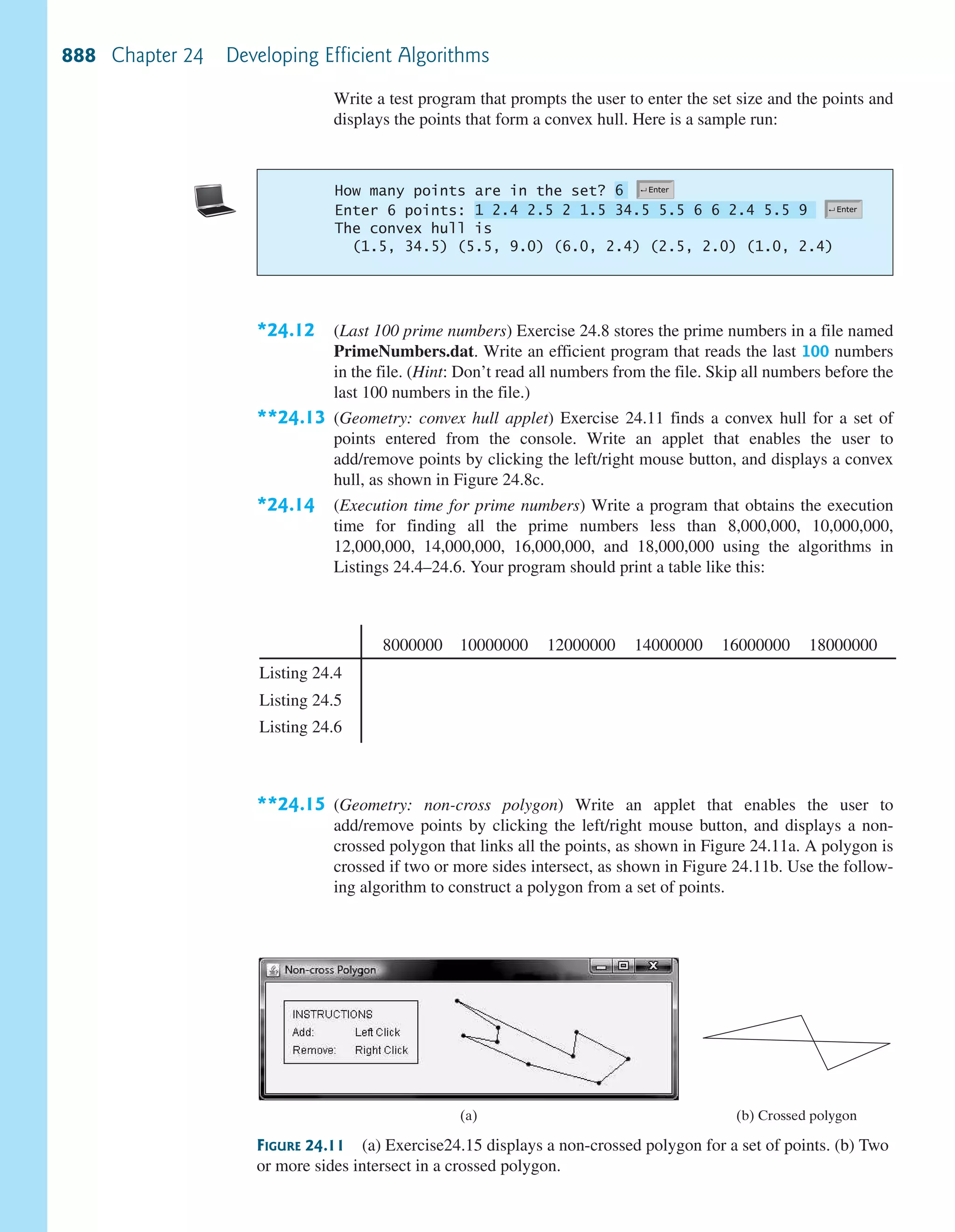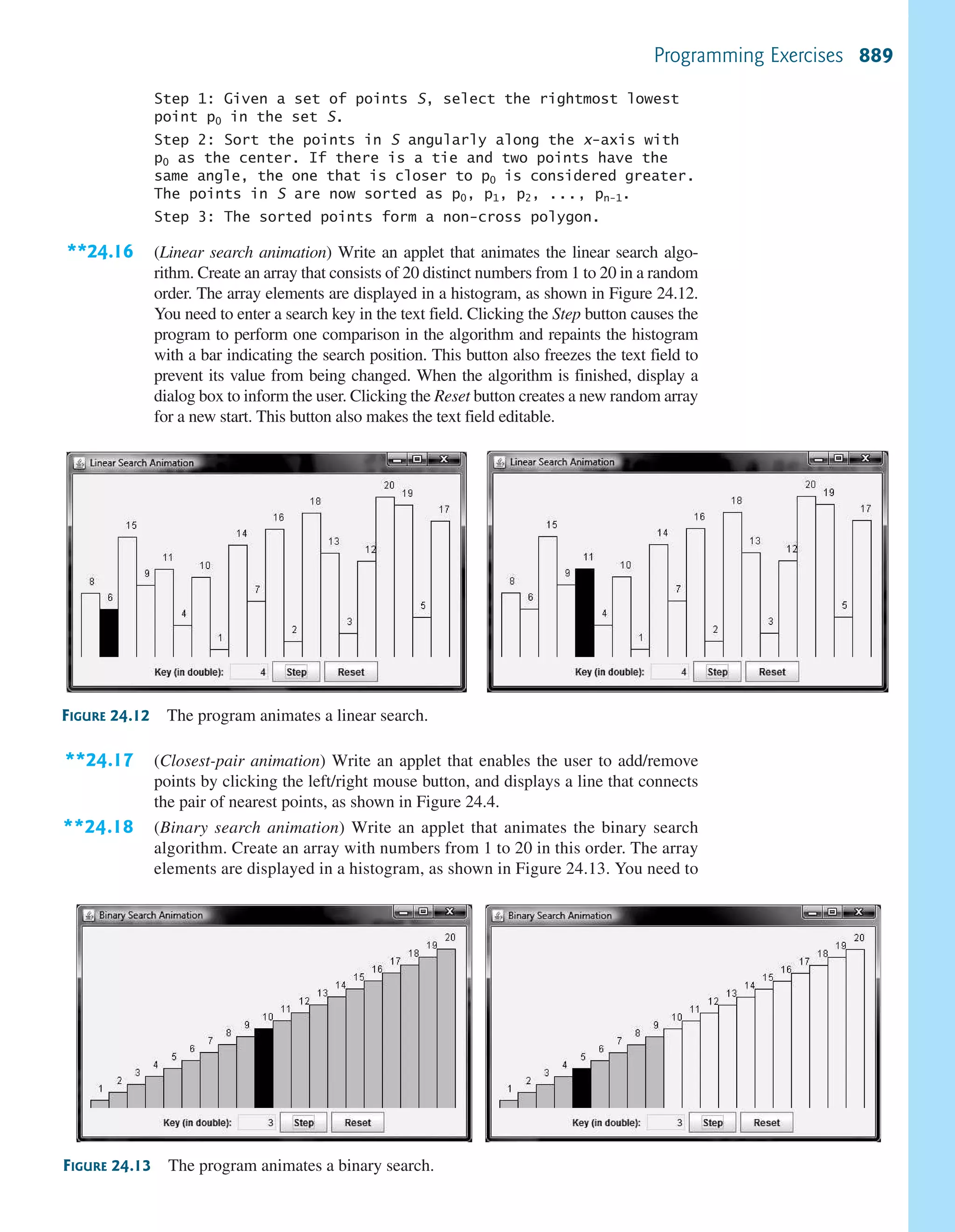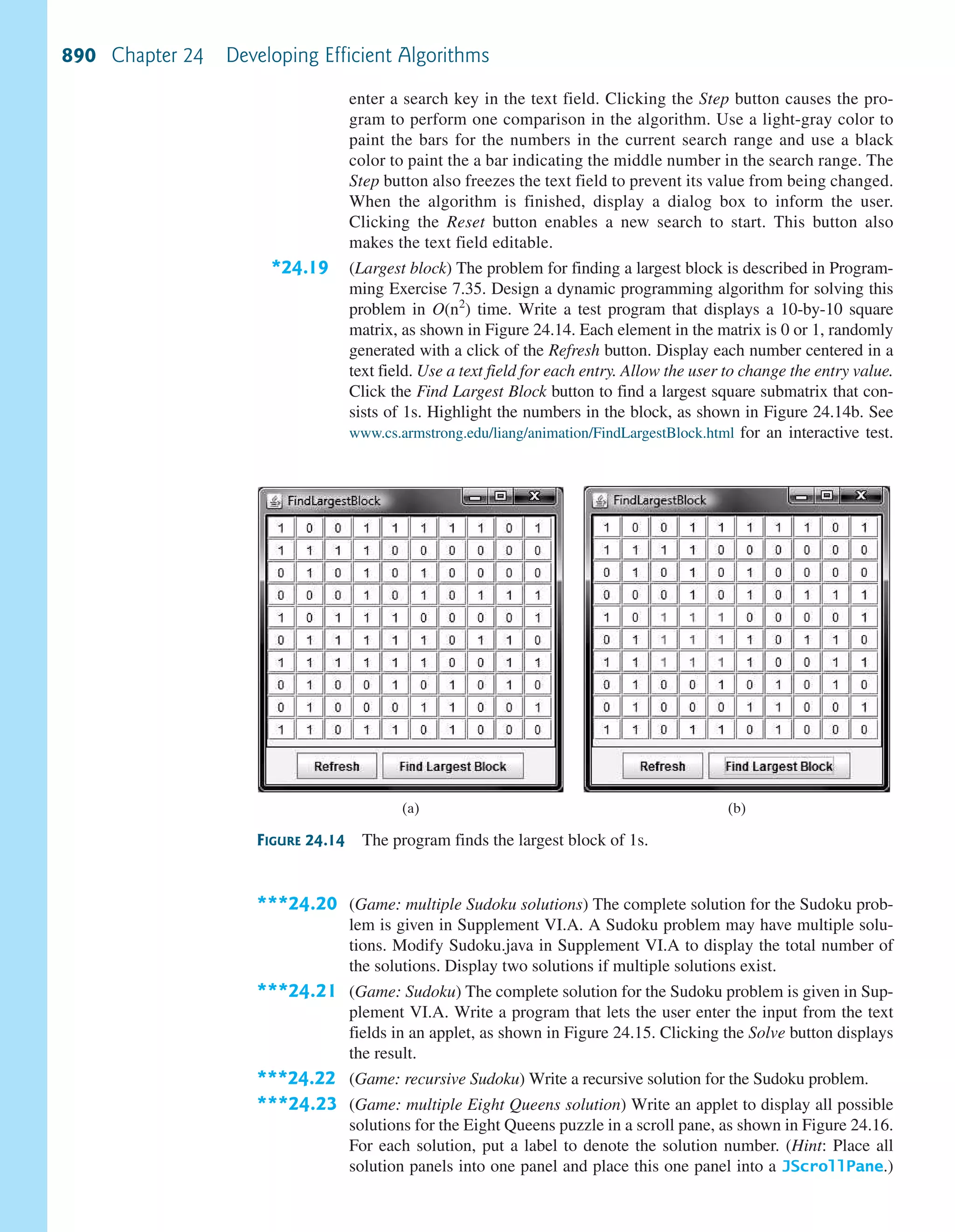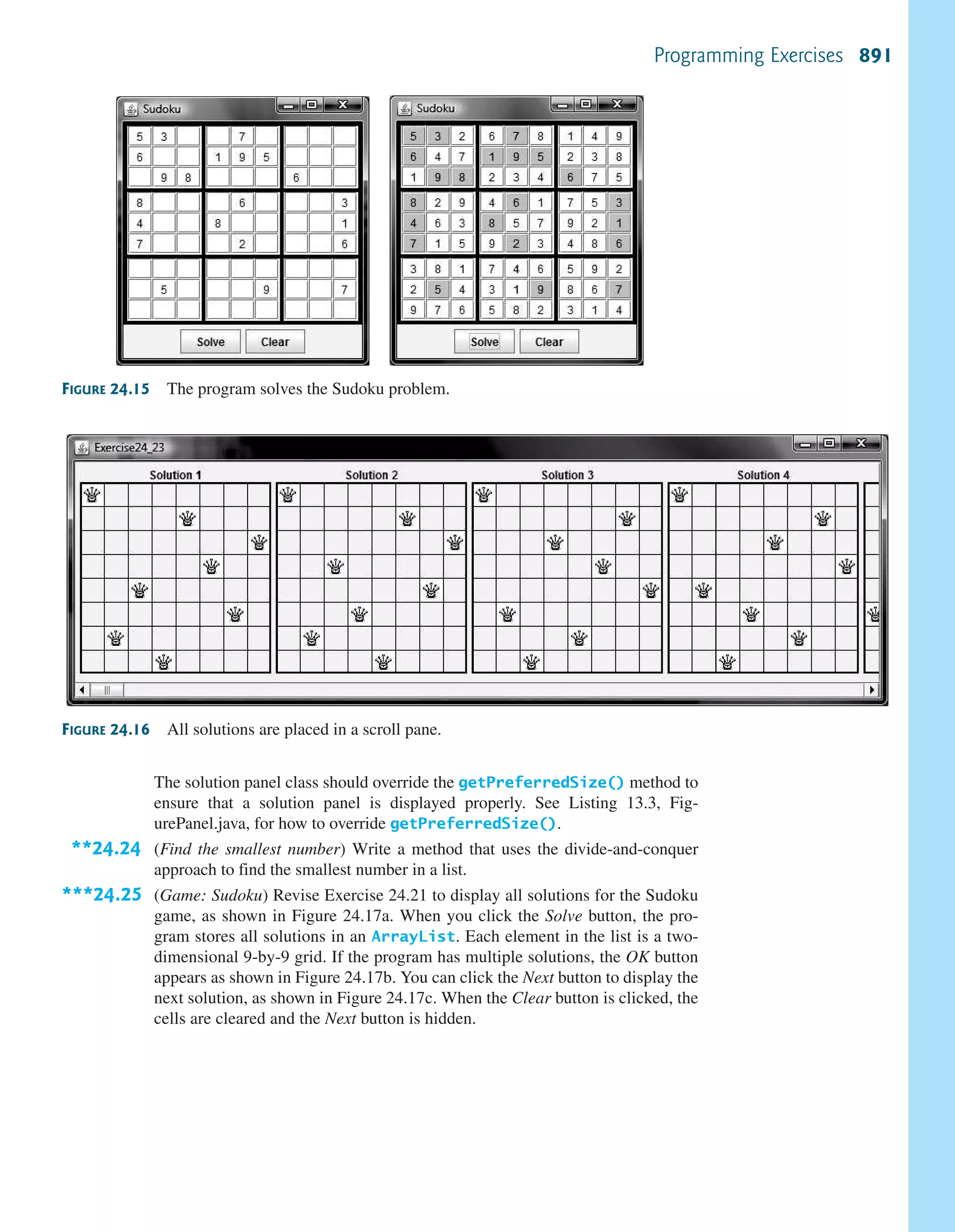This document discusses analyzing the efficiency of algorithms. It begins by explaining how to measure algorithm efficiency using Big O notation, which estimates how fast an algorithm's execution time grows as the input size increases. Common growth rates like constant, logarithmic, linear, and quadratic time are described. Examples are provided to demonstrate determining the Big O of various algorithms. Specific algorithms analyzed in more depth include binary search, selection sort, insertion sort, and Towers of Hanoi. The document aims to introduce techniques for developing efficient algorithms using approaches like dynamic programming, divide-and-conquer, and backtracking.


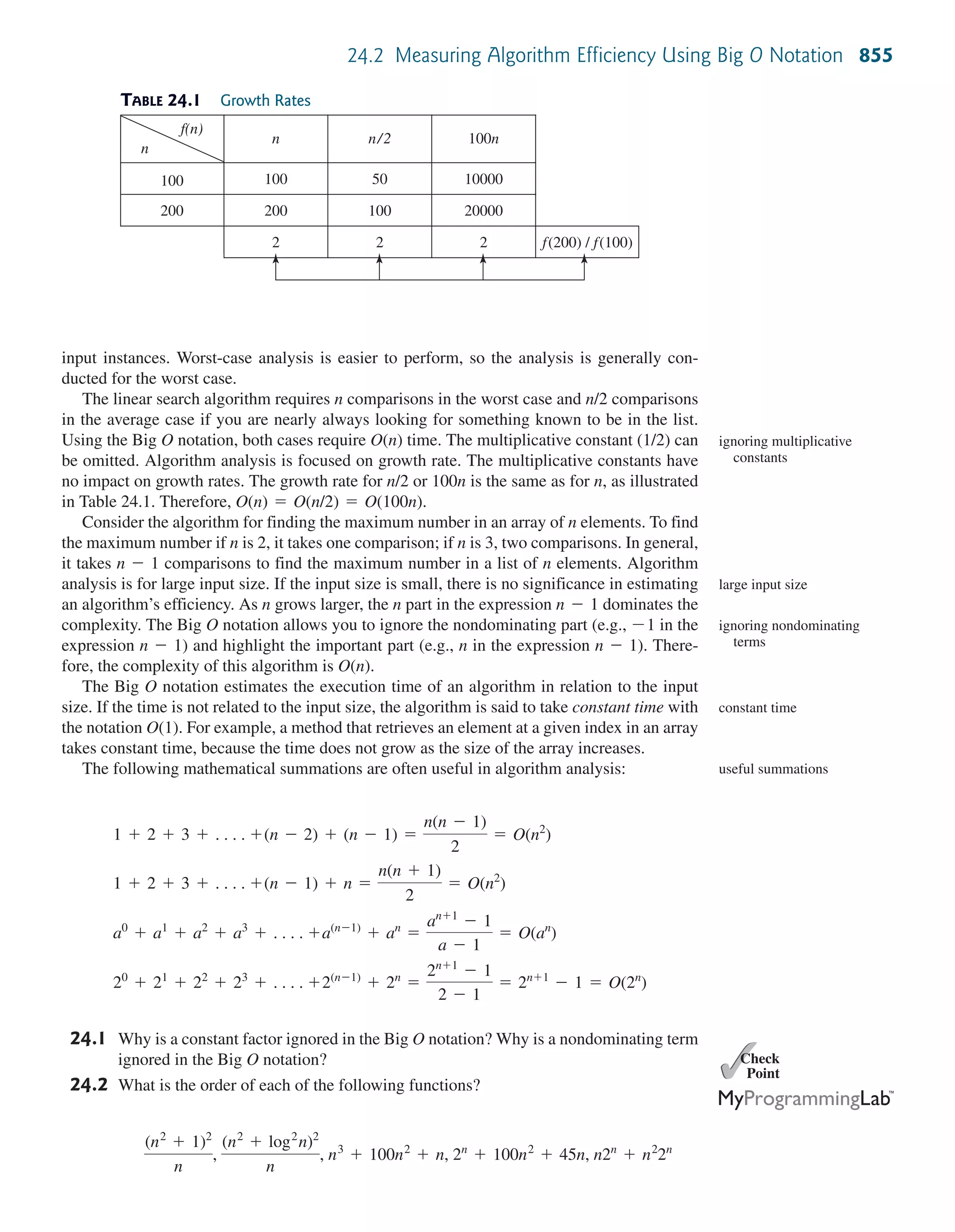
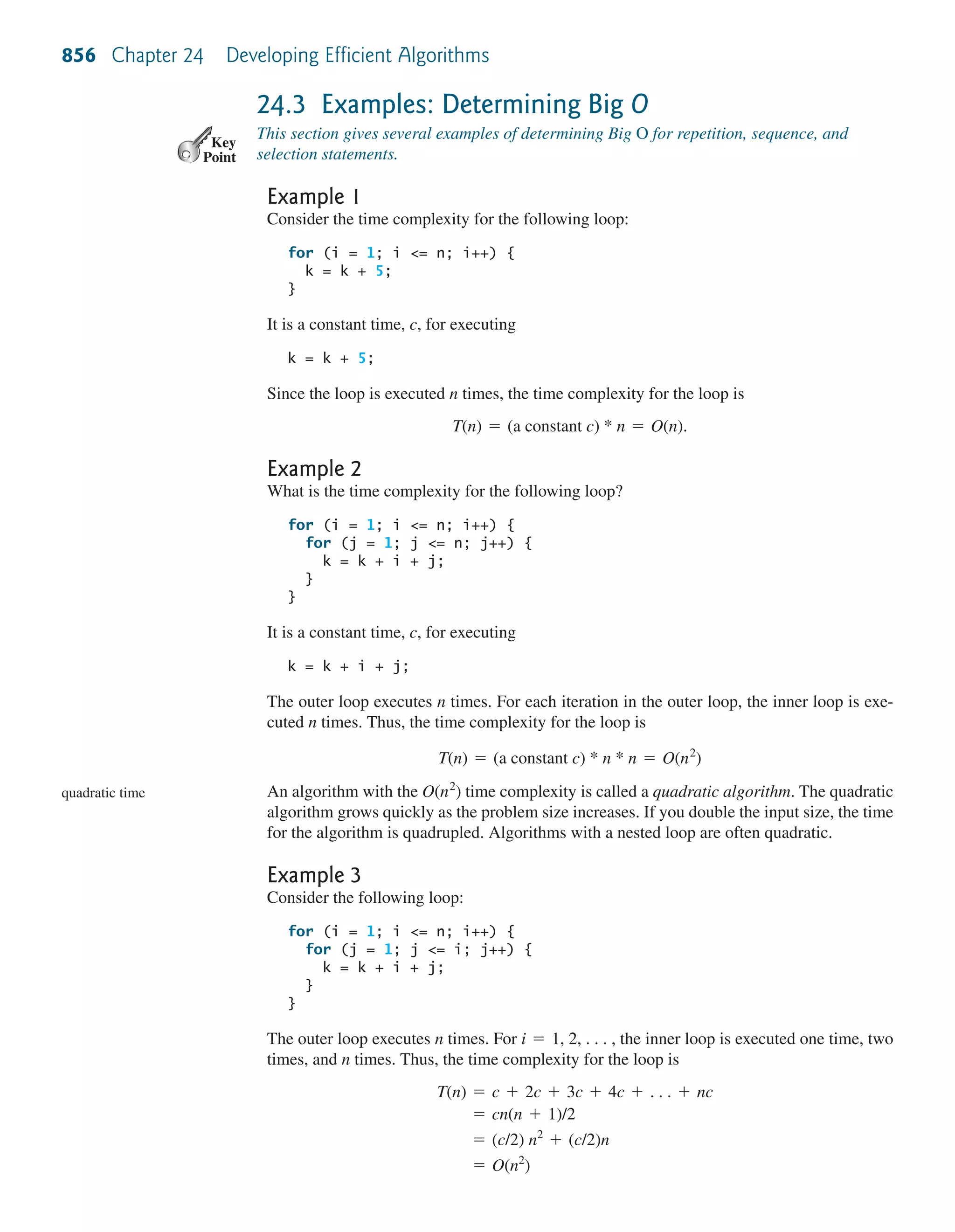
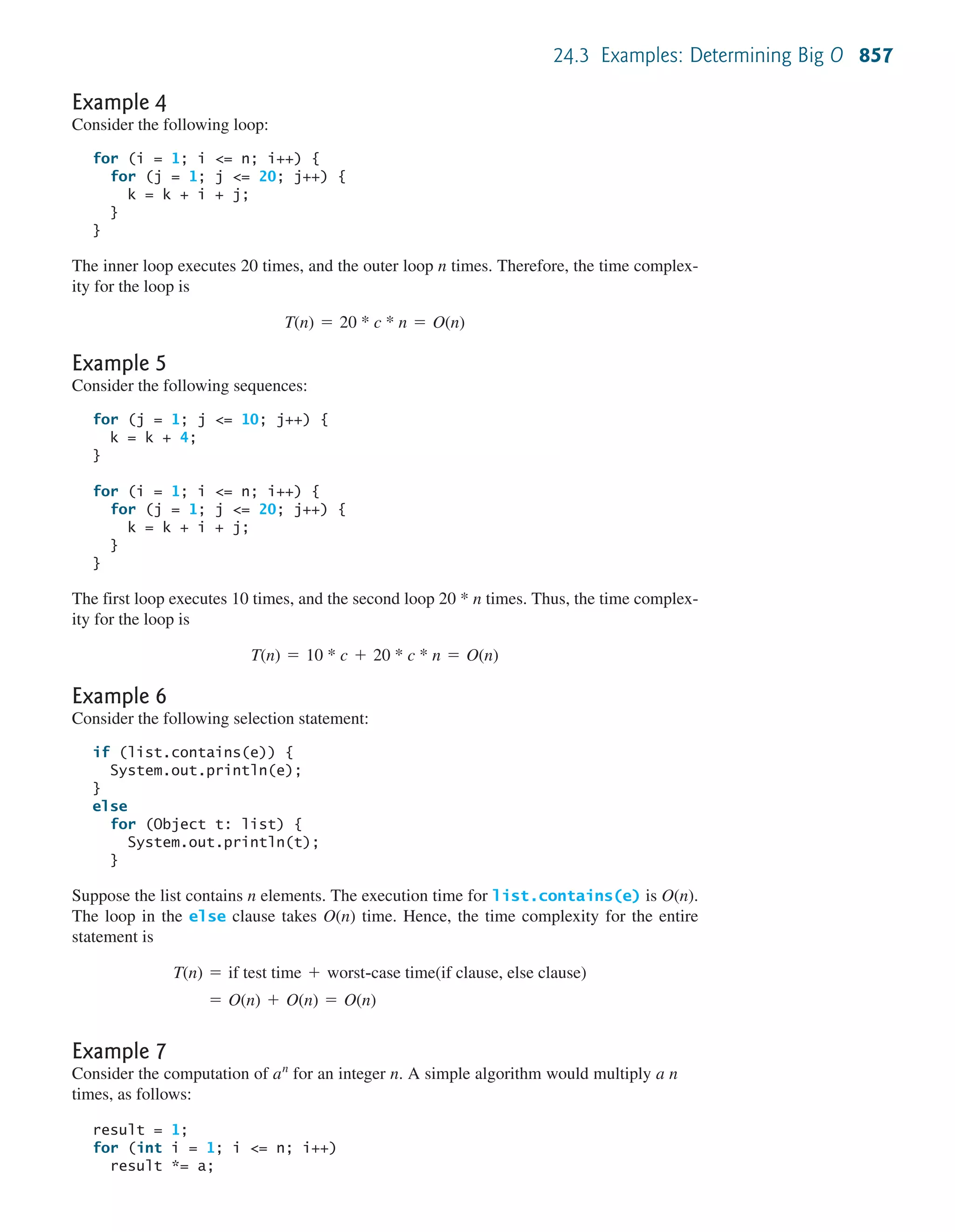
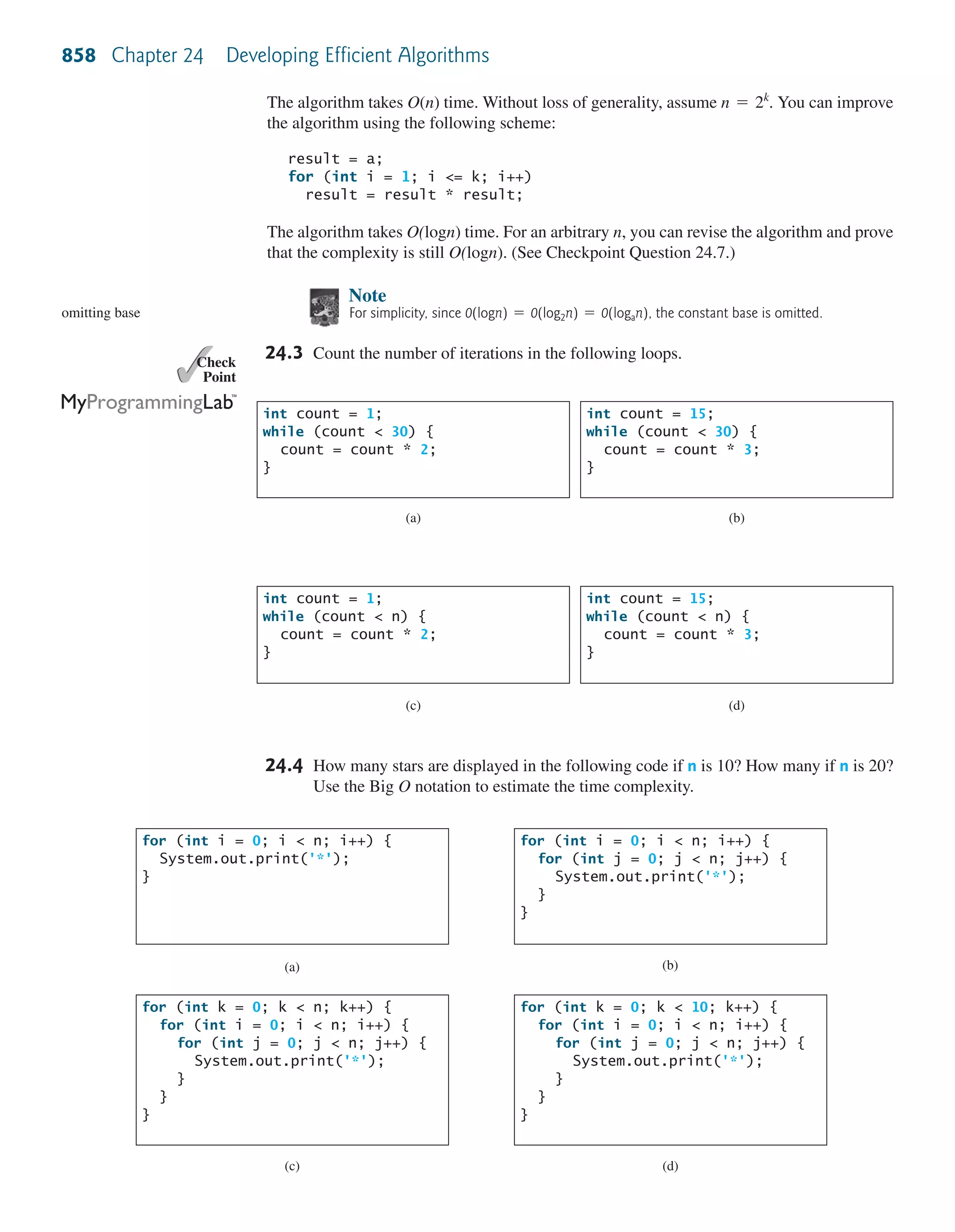
![24.4 Analyzing Algorithm Time Complexity 859
24.5 Use the Big O notation to estimate the time complexity of the following methods:
public static void mA(int n) {
for (int i = 0; i < n; i++) {
System.out.print(Math.random());
}
}
public static void mB(int n) {
for (int i = 0; i < n; i++) {
for (int j = 0; j < i; j++)
System.out.print(Math.random());
}
}
public static void mC(int[] m) {
for (int i = 0; i < m.length; i++) {
System.out.print(m[i]);
}
for (int i = m.length - 1; i >= 0; )
{
System.out.print(m[i]);
i--;
}
}
24.6 Design an O(n) time algorithm for computing the sum of numbers from n1 to n2 for
Can you design an O(1) for performing the same task?
24.7 Example 7 in Section 24.3 assumes Revise the algorithm for an arbitrary n
and prove that the complexity is still O(logn).
24.4 Analyzing Algorithm Time Complexity
This section analyzes the complexity of several well-known algorithms: binary search,
selection sort, insertion sort, and Towers of Hanoi.
24.4.1 Analyzing Binary Search
The binary search algorithm presented in Listing 6.7, BinarySearch.java, searches for a key in
a sorted array. Each iteration in the algorithm contains a fixed number of operations, denoted
by c. Let T(n) denote the time complexity for a binary search on a list of n elements. Without
loss of generality, assume n is a power of 2 and Since a binary search eliminates
half of the input after two comparisons,
Ignoring constants and nondominating terms, the complexity of the binary search algorithm is
O(logn). An algorithm with the O(logn) time complexity is called a logarithmic algorithm.
The base of the log is 2, but the base does not affect a logarithmic growth rate, so it can be
omitted. The logarithmic algorithm grows slowly as the problem size increases. In the case of
binary search, each time you double the array size, at most one more comparison will be
required. If you square the input size of any logarithmic time algorithm, you only double the
time of execution. So a logarithmic-time algorithm is very efficient.
= O(logn)
= T(1) + c logn = 1 + (logn)c
T(n) = T ¢
n
2
≤ + c = T ¢
n
22
≤ + c + c = T ¢
n
2k
≤ + kc
k = logn.
n = 2k
.
(n1 6 n2).
public static void mD(int[] m) {
for (int i = 0; i < m.length; i++) {
for (int j = 0; j < i; j++)
System.out.print(m[i] * m[j]);
}
}
Key
Point
binary search animation on
the Companion Website
logarithmic time
(a) (b)
(d)(c)](https://image.slidesharecdn.com/ch24efficientalgorithms-140813175338-phpapp02/75/Ch24-efficient-algorithms-7-2048.jpg)
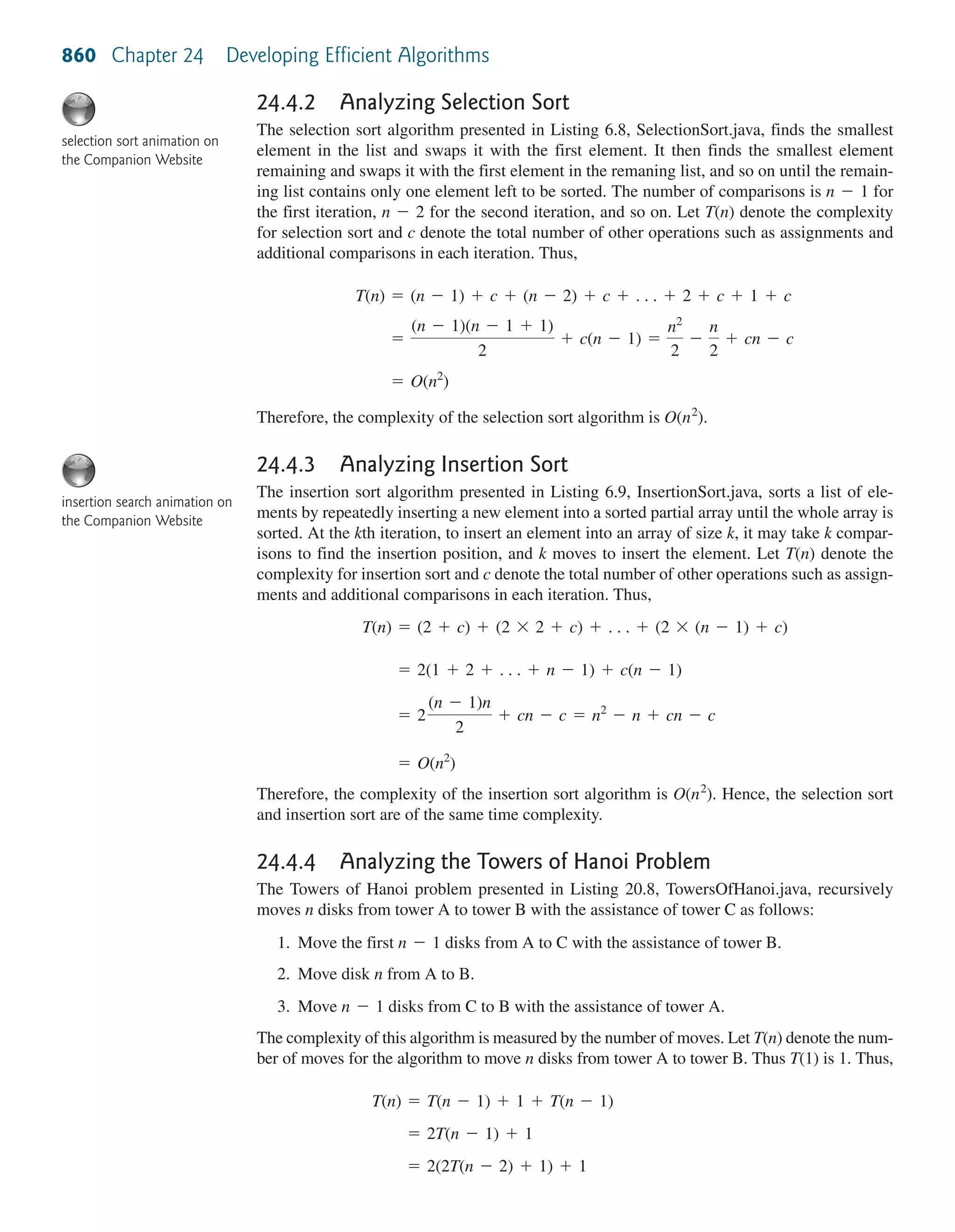
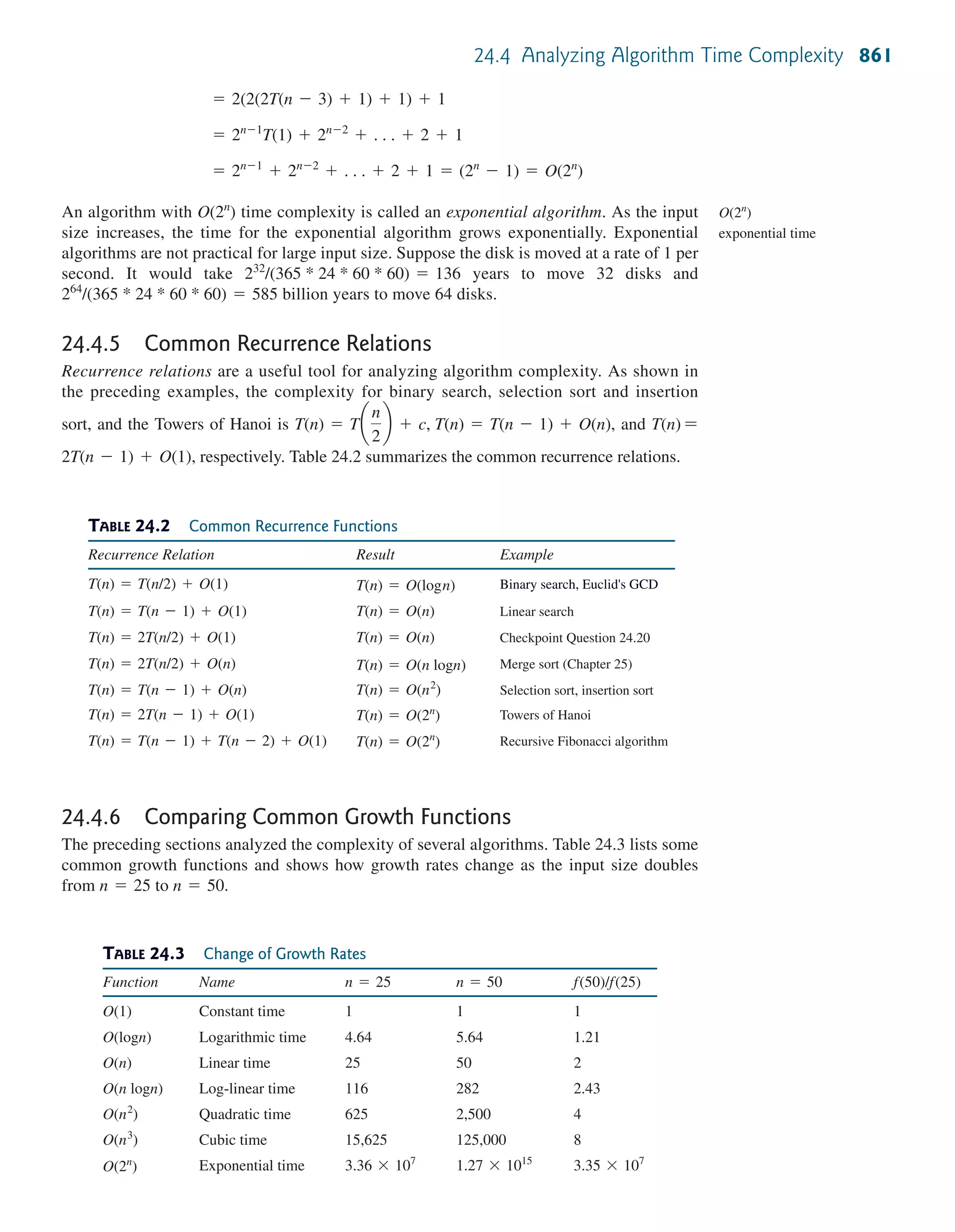
![862 Chapter 24 Developing Efficient Algorithms
✓Point✓Check
Key
Point
O(1)
O(logn)
O(n)
O(nlogn)
O(2n
) O(n3
)
O(n2
)
FIGURE 24.1 As the size n increases, the function grows.
These functions are ordered as follows, as illustrated in Figure 24.1.
O(1) 6 O(logn) 6 O(n) 6 O(n logn) 6 O(n2
) 6 O(n3
) 6 O(2n
)
24.8 Put the following growth functions in order:
24.9 Estimate the time complexity for adding two matrices, and for multiplying an
matrix by an matrix.
24.10 Describe an algorithm for finding the occurrence of the max element in an array.
Analyze the complexity of the algorithm.
24.11 Describe an algorithm for removing duplicates from an array. Analyze the complex-
ity of the algorithm.
24.12 Analyze the following sorting algorithm:
for (int i = 0; i < list.length - 1; i++) {
if (list[i] > list[i + 1]) {
swap list[i] with list[i + 1];
i = -1;
}
}
24.5 Finding Fibonacci Numbers Using Dynamic
Programming
This section analyzes and designs an efficient algorithm for finding Fibonacci numbers
using dynamic programming.
Section 20.3, Case Study: Computing Fibonacci Numbers, gave a recursive method for find-
ing the Fibonacci number, as follows:
/** The method for finding the Fibonacci number */
public static long {
if (index == 0) // Base case
return 0;
else if (index == 1) // Base case
return 1;
else // Reduction and recursive calls
return ;
}
fib(index - 1) + fib(index - 2)
fib(long index)
m * kn * m
n * m
5n3
4032
, 44 logn, 10n logn, 500, 2n2
,
2n
45
, 3n](https://image.slidesharecdn.com/ch24efficientalgorithms-140813175338-phpapp02/75/Ch24-efficient-algorithms-10-2048.jpg)
![24.5 Finding Fibonacci Numbers Using Dynamic Programming 863
f0 f1 f2
Fibonacci series: 0 1 1 2 3 5 8 13 21 34 55 89 ...
indices: 0 1 2 3 4 5 6 7 8 9 10 11
f0 f1 f2
Fibonacci series: 0 1 1 2 3 5 8 13 21 34 55 89 ...
indices: 0 1 2 3 4 5 6 7 8 9 10 11
f0 f1 f2
Fibonacci series: 0 1 1 2 3 5 8 13 21 34 55 89 ...
indices: 0 1 2 3 4 5 6 7 8 9 10 11
We can now prove that the complexity of this algorithm is For convenience, let the
index be n. Let T(n) denote the complexity for the algorithm that finds fib(n) and c denote
the constant time for comparing the index with 0 and 1; that is, T(1) is c. Thus,
Similar to the analysis of the Towers of Hanoi problem, we can show that T(n) is
However, this algorithm is not efficient. Is there an efficient algorithm for finding a
Fibonacci number? The trouble with the recursive fib method is that the method is invoked
redundantly with the same arguments. For example, to compute fib(4), fib(3) and
fib(2) are invoked. To compute fib(3), fib(2) and fib(1) are invoked. Note that
fib(2) is redundantly invoked. We can improve it by avoiding repeated calling of the fib
method with the same argument. Note that a new Fibonacci number is obtained by adding the
preceding two numbers in the sequence. If you use the two variables f0 and f1 to store the
two preceding numbers, the new number, f2, can be immediately obtained by adding f0 with
f1. Now you should update f0 and f1 by assigning f1 to f0 and assigning f2 to f1, as
shown in Figure 24.2.
O(2n
).
= 22
T(n - 2) + 2c + c
… 2(2T(n - 2) + c) + c
… 2T(n - 1) + c
T(n) = T(n - 1) + T(n - 2) + c
O(2n
).
The new method is implemented in Listing 24.1.
LISTING 24.1 ImprovedFibonacci.java
1 import java.util.Scanner;
2
3 public class ImprovedFibonacci {
4 /** Main method */
5 public static void main(String args[]) {
6 // Create a Scanner
7 Scanner input = new Scanner(System.in);
8 System.out.print("Enter an index for the Fibonacci number: ");
9
10
11 // Find and display the Fibonacci number
12 System.out.println(
13 "Fibonacci number at index " + index + " is " + );
14 }
15
16 /** The method for finding the Fibonacci number */
fib(index)
int index = input.nextInt(); input
invoke fib
FIGURE 24.2 Variables f0, f1, and f2 store three consecutive Fibonacci numbers in the series.](https://image.slidesharecdn.com/ch24efficientalgorithms-140813175338-phpapp02/75/Ch24-efficient-algorithms-11-2048.jpg)
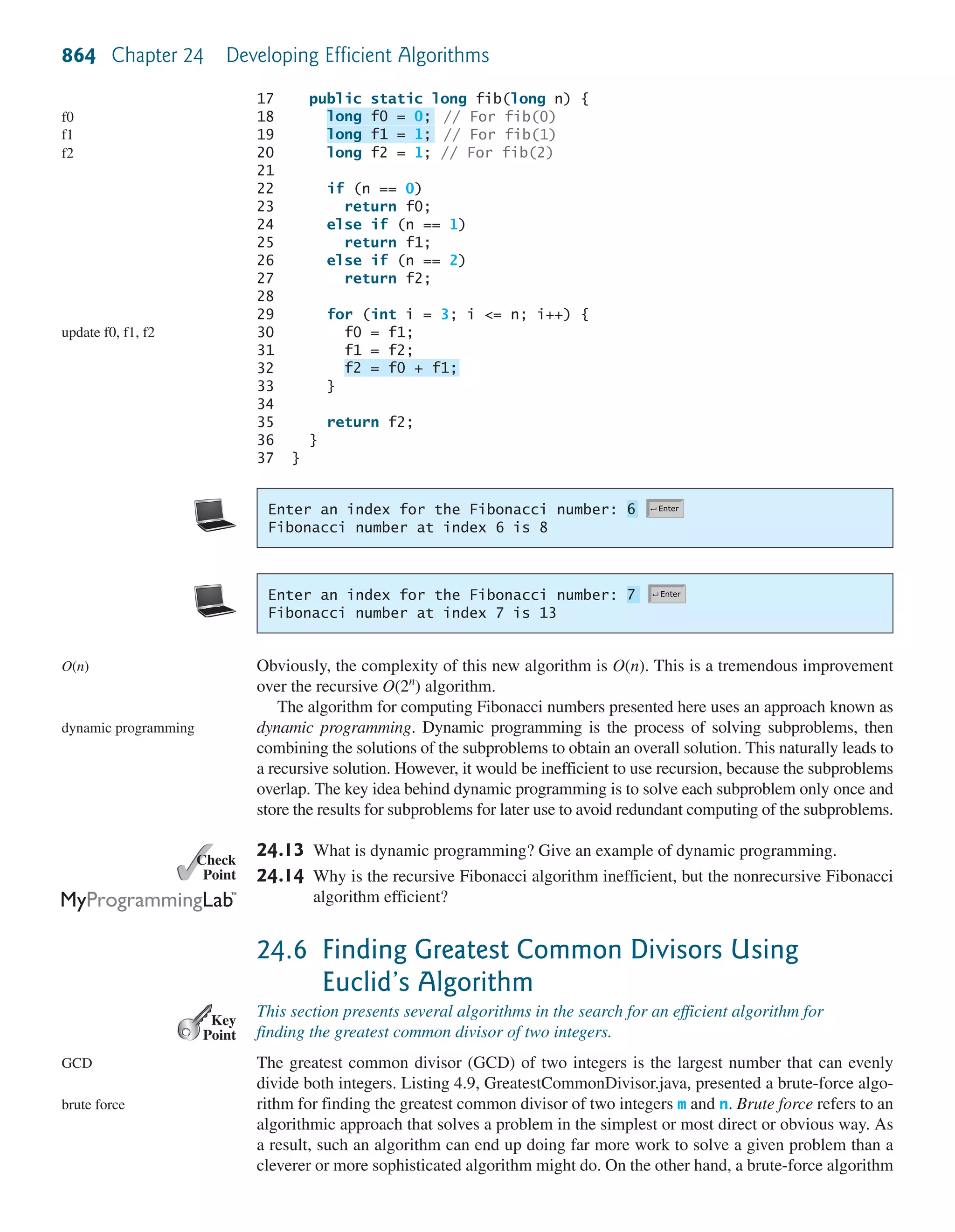
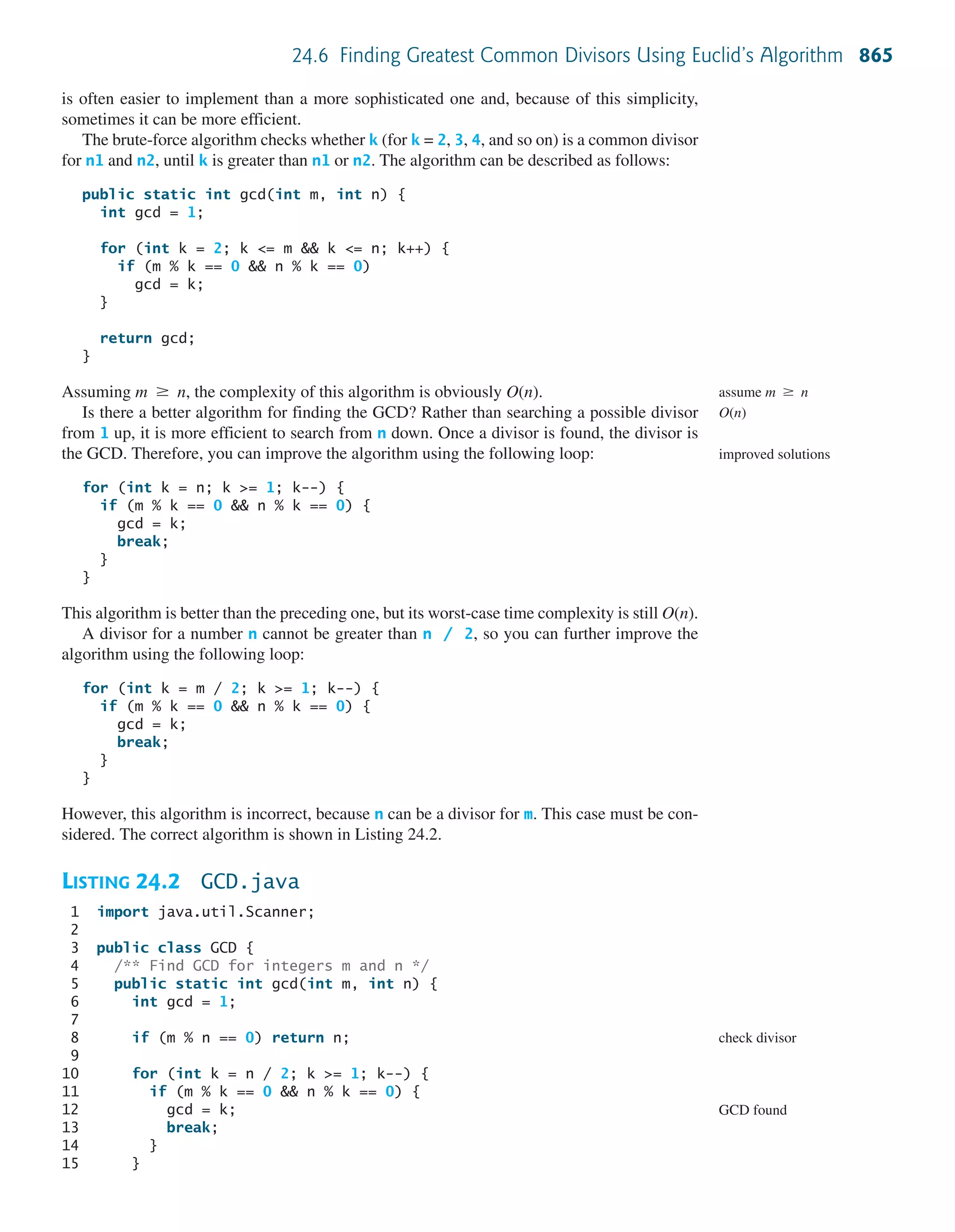
![866 Chapter 24 Developing Efficient Algorithms
16
17 return gcd;
18 }
19
20 /** Main method */
21 public static void main(String[] args) {
22 // Create a Scanner
23 Scanner input = new Scanner(System.in);
24
25 // Prompt the user to enter two integers
26 System.out.print("Enter first integer: ");
27 int m = input.nextInt();
28 System.out.print("Enter second integer: ");
29 int n = input.nextInt();
30
31 System.out.println("The greatest common divisor for " + m +
32 " and " + n + " is " + gcd(m, n));
33 }
34 }
input
input
Enter first integer:
Enter second integer:
The greatest common divisor for 2525 and 125 is 25
125
2525
Enter first integer:
Enter second integer:
The greatest common divisor for 3 and 3 is 3
3
3
Assuming the for loop is executed at most n/2 times, which cuts the time by half
from the previous algorithm. The time complexity of this algorithm is still O(n), but practi-
cally, it is much faster than the algorithm in Listing 4.8.
Note
The Big O notation provides a good theoretical estimate of algorithm efficiency. How-
ever, two algorithms of the same time complexity are not necessarily equally efficient. As
shown in the preceding example, both algorithms in Listings 4.9 and 24.2 have the same
complexity, but in practice the one in Listing 24.2 is obviously better.
A more efficient algorithm for finding the GCD was discovered by Euclid around 300 B.C.
This is one of the oldest known algorithms. It can be defined recursively as follows:
Let gcd(m, n) denote the GCD for integers m and n:
■ If m % n is 0, gcd (m, n) is n.
■ Otherwise, gcd(m, n) is gcd(n, m % n).
It is not difficult to prove the correctness of this algorithm. Suppose m % n = r. Thus, m =
qn + r, where q is the quotient of m / n. Any number that is divisible by m and n must also
be divisible by r. Therefore, gcd(m, n) is the same as gcd(n, r), where r = m % n. The
algorithm can be implemented as in Listing 24.3.
LISTING 24.3 GCDEuclid.java
1 import java.util.Scanner;
2
3 public class GCDEuclid {
m Ն n,
O(n)
practical consideration
Euclid’s algorithm](https://image.slidesharecdn.com/ch24efficientalgorithms-140813175338-phpapp02/75/Ch24-efficient-algorithms-14-2048.jpg)
![4 /** Find GCD for integers m and n */
5 public static int gcd(int m, int n) {
6 if (m % n == 0)
7 return n;
8 else
9 return gcd(n, m % n);
10 }
11
12 /** Main method */
13 public static void main(String[] args) {
14 // Create a Scanner
15 Scanner input = new Scanner(System.in);
16
17 // Prompt the user to enter two integers
18 System.out.print("Enter first integer: ");
19 int m = input.nextInt();
20 System.out.print("Enter second integer: ");
21 int n = input.nextInt();
22
23 System.out.println("The greatest common divisor for " + m +
24 " and " + n + " is " + gcd(m, n));
25 }
26 }
base case
reduction
input
input
Enter first integer:
Enter second integer:
The greatest common divisor for 2525 and 125 is 25
125
2525
Enter first integer:
Enter second integer:
The greatest common divisor for 3 and 3 is 3
3
3
In the best case when m % n is 0, the algorithm takes just one step to find the GCD. It is dif-
ficult to analyze the average case. However, we can prove that the worst-case time complexity
is O(logn).
Assuming we can show that m % n < m / 2, as follows:
■ If n <= m / 2, m % n < m / 2, since the remainder of m divided by n is always
less than n.
■ If n > m / 2, m % n = m – n < m / 2. Therefore, m % n < m / 2.
Euclid’s algorithm recursively invokes the gcd method. It first calls gcd(m, n), then calls
gcd(n, m % n), and gcd(m % n, n % (m % n)), and so on, as follows:
gcd(m, n)
= gcd(n, m % n)
= gcd(m % n, n % (m % n))
= ...
Since m % n < m / 2 and n % (m % n) < n / 2, the argument passed to the gcd method
is reduced by half after every two iterations. After invoking gcd two times, the second para-
meter is less than n/2. After invoking gcd four times, the second parameter is less than n/4.
After invoking gcd six times, the second parameter is less than Let k be the number of
n
23
.
m Ն n,
best case
average case
worst case
24.6 Finding Greatest Common Divisors Using Euclid’s Algorithm 867](https://image.slidesharecdn.com/ch24efficientalgorithms-140813175338-phpapp02/75/Ch24-efficient-algorithms-15-2048.jpg)
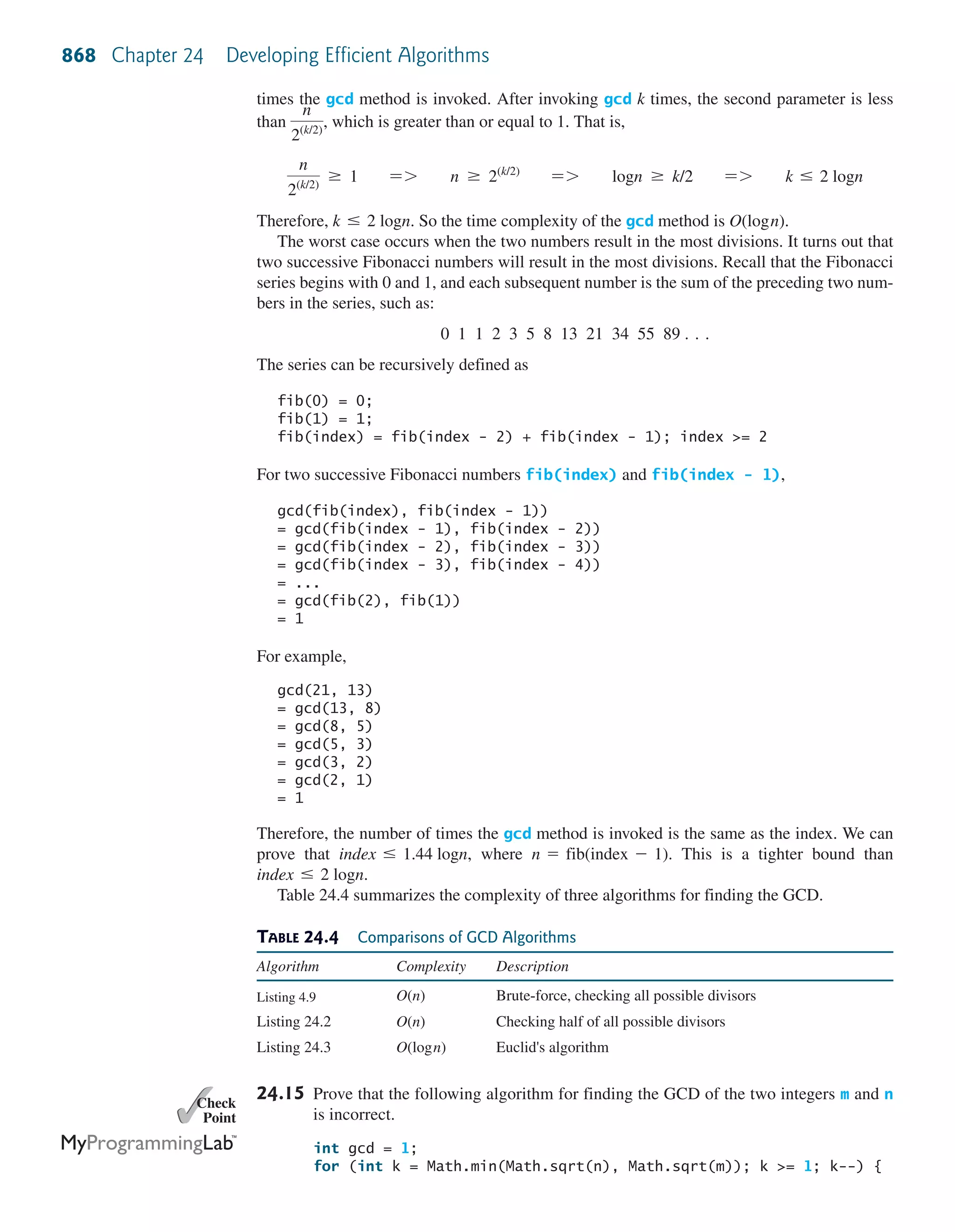
![24.7 Efficient Algorithms for Finding Prime Numbers 869
Key
Point
if (m % k == 0 && n % k == 0) {
gcd = k;
break;
}
}
24.7 Efficient Algorithms for Finding Prime Numbers
This section presents several algorithms in the search for an efficient algorithm for
finding prime numbers.
A $150,000 award awaits the first individual or group who discovers a prime number with at
least 100,000,000 decimal digits (w2.eff.org/awards/coop-prime-rules.php).
Can you design a fast algorithm for finding prime numbers?
An integer greater than 1 is prime if its only positive divisor is 1 or itself. For example, 2,
3, 5, and 7 are prime numbers, but 4, 6, 8, and 9 are not.
How do you determine whether a number n is prime? Listing 4.14 presented a brute-force
algorithm for finding prime numbers. The algorithm checks whether 2, 3, 4, 5, . . . , or n - 1
is divisible by n. If not, n is prime. This algorithm takes O(n) time to check whether n is
prime. Note that you need to check only whether 2, 3, 4, 5, . . . , and n/2 is divisible by n. If
not, n is prime. This algorithm is slightly improved, but it is still of O(n).
In fact, we can prove that if n is not a prime, n must have a factor that is greater than 1 and
less than or equal to Here is the proof. Since n is not a prime, there exist two numbers p
and q such that n pq with Note that p must be less than or equal
to Hence, you need to check only whether 2, 3, 4, 5, . . . , or is divisible by n. If not,
n is prime. This significantly reduces the time complexity of the algorithm to
Now consider the algorithm for finding all the prime numbers up to n. A straightforward
implementation is to check whether i is prime for i 2, 3, 4, . . . , n. The program is given
in Listing 24.4.
LISTING 24.4 PrimeNumbers.java
1 import java.util.Scanner;
2
3 public class PrimeNumbers {
4 public static void main(String[] args) {
5 Scanner input = new Scanner(System.in);
6 System.out.print("Find all prime numbers <= n, enter n: ");
7 int n = input.nextInt();
8
9 final int NUMBER_PER_LINE = 10; // Display 10 per line
10 int count = 0; // Count the number of prime numbers
11 int number = 2; // A number to be tested for primeness
12
13 System.out.println("The prime numbers are:");
14
15 // Repeatedly find prime numbers
16
17 // Assume the number is prime
18 boolean isPrime = true; // Is the current number prime?
19
20 // Test if number is prime
21
22
23 if (number % divisor == 0) { // If true, number is not prime
24 isPrime = false; // Set isPrime to false
25 break; // Exit the for loop
divisor++) {
for (int divisor = 2; divisor <= (int)(Math.sqrt(number));
while (number <= n) {
=
O(2n).
2n2n.
n = 2n 2n.1 6 p … q.=
2n.
what is prime?
check prime](https://image.slidesharecdn.com/ch24efficientalgorithms-140813175338-phpapp02/75/Ch24-efficient-algorithms-17-2048.jpg)
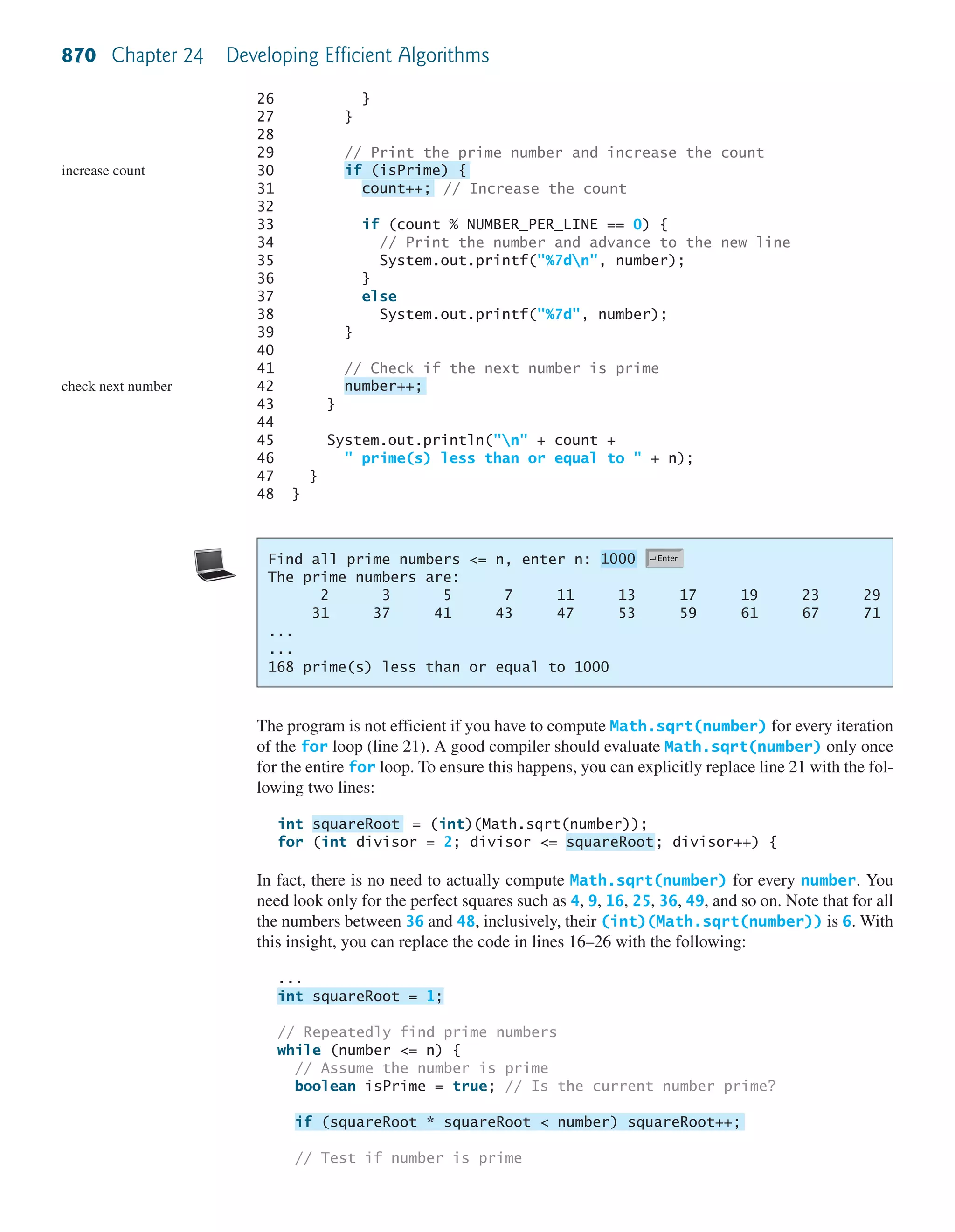
![24.7 Efficient Algorithms for Finding Prime Numbers 871
for (int divisor = 2; divisor <= squareRoot; divisor++) {
if (number % divisor == 0) { // If true, number is not prime
isPrime = false; // Set isPrime to false
break; // Exit the for loop
}
}
...
Now we turn our attention to analyzing the complexity of this program. Since it takes
steps in the for loop (lines 21–27) to check whether number i is prime, the algorithm takes
steps to find all the prime numbers less than or equal to n.
Observe that
Therefore, the time complexity for this algorithm is
To determine whether i is prime, the algorithm checks whether 2, 3, 4, 5, . . . , and are
divisible by i. This algorithm can be further improved. In fact, you need to check only whether
the prime numbers from 2 to are possible divisors for i.
We can prove that if i is not prime, there must exist a prime number p such that and
Here is the proof. Assume that i is not prime; let p be the smallest factor of i. p must
be prime, otherwise, p has a factor k with k is also a factor of i, which contradicts
that p be the smallest factor of i. Therefore, if i is not prime, you can find a prime number
from 2 to that is divisible by i. This leads to a more efficient algorithm for finding all
prime numbers up to n, as shown in Listing 24.5.
LISTING 24.5 EfficientPrimeNumbers.java
1 import java.util.Scanner;
2
3 public class EfficientPrimeNumbers {
4 public static void main(String[] args) {
5 Scanner input = new Scanner(System.in);
6 System.out.print("Find all prime numbers <= n, enter n: ");
7 int n = input.nextInt();
8
9 // A list to hold prime numbers
10 java.util.List<Integer> list =
11 new java.util.ArrayList<Integer>();
12
13 final int NUMBER_PER_LINE = 10; // Display 10 per line
14 int count = 0; // Count the number of prime numbers
15 int number = 2; // A number to be tested for primeness
16 // Check whether number <= squareRoot
17
18 System.out.println("The prime numbers are n");
19
20 // Repeatedly find prime numbers
21 while (number <= n) {
22 // Assume the number is prime
23 boolean isPrime = true; // Is the current number prime?
24
25
26
27 // Test whether number is prime
28 for (int k = 0; k < list.size()
29 && list.get(k) <= squareRoot; k++) {
30 if (number % list.get(k) == 0) { // If true, not prime
if (squareRoot * squareRoot < number) squareRoot++;
int squareRoot = 1;
2i
2 … k 6 p.
p … q.
i = pq
2i
2i
O(n2n).
22 + 23 + 24 + . . . + 2n … n2n
22 + 23 + 24 + . . . + 2n
2i
check prime](https://image.slidesharecdn.com/ch24efficientalgorithms-140813175338-phpapp02/75/Ch24-efficient-algorithms-19-2048.jpg)
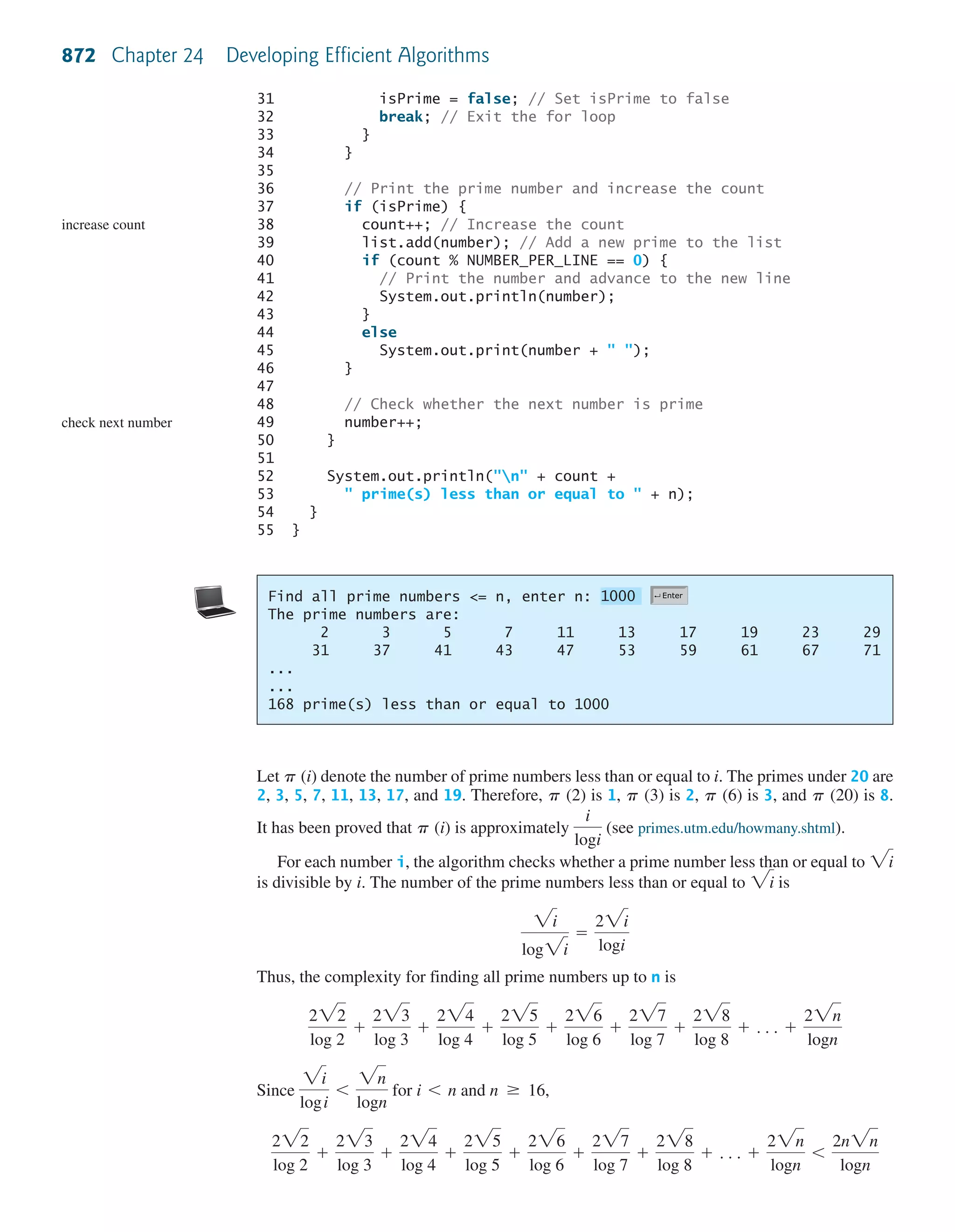
![24.7 Efficient Algorithms for Finding Prime Numbers 873
ϫ ϫ T T T T T T T T T T T T T T T T T T T T T T T T T Tinitial
0 1 2 3 4 5 6 7 8 9 10 11 12 13 14 15 16 17 18 19 20 21 22 23 24 25 26 27
k = 2
index
primes array
ϫ ϫ T T F T F T F T F T F T F T F T F T F T F T F T F T
k = 3 ϫ ϫ T T F T F T F F F T F T F F F T F T F F F T F T F F
k = 5 ϫ ϫ T T F T F T F F F T F T F F F T F T F F F T F F F F
Figure 24.3 The values in primes are changed with each prime number k.
Therefore, the complexity of this algorithm is
This algorithm is another example of dynamic programming. The algorithm stores the
results of the subproblems in the array list and uses them later to check whether a new num-
ber is prime.
Is there any algorithm better than Let us examine the well-known Eratosthenes
algorithm for finding prime numbers. Eratosthenes (276–194 B.C.) was a Greek mathematician
who devised a clever algorithm, known as the Sieve of Eratosthenes, for finding all prime num-
bers His algorithm is to use an array named primes of n Boolean values. Initially, all ele-
ments in primes are set true. Since the multiples of 2 are not prime, set primes[2 * i] to
false for all as shown in Figure 24.3. Since we don’t care about primes[0]
and primes[1], these values are marked in the figure.*
2 … i … n/2,
… n.
O¢
n2n
logn
≤?
O¢
n2n
logn
≤.
dynamic programming
Sieve of Eratosthenes
Since the multiples of 3 are not prime, set primes[3 * i] to false for all
Because the multiples of 5 are not prime, set primes[5 * i] to false for all
Note that you don’t need to consider the multiples of 4, because the multiples of 4 are also the
multiples of 2, which have already been considered. Similarly, multiples of 6, 8, and 9 need
not be considered. You only need to consider the multiples of a prime number k = 2, 3, 5, 7,
11, . . . , and set the corresponding element in primes to false. Afterward, if primes[i]
is still true, then i is a prime number. As shown in Figure 24.3, 2, 3, 5, 7, 11, 13, 17, 19, and
23 are prime numbers. Listing 24.6 gives the program for finding the prime numbers using the
Sieve of Eratosthenes algorithm.
LISTING 24.6 SieveOfEratosthenes.java
1 import java.util.Scanner;
2
3 public class SieveOfEratosthenes {
4 public static void main(String[] args) {
5 Scanner input = new Scanner(System.in);
6 System.out.print("Find all prime numbers <= n, enter n: ");
7 int n = input.nextInt();
8
9 // Prime number sieve
10
11 // Initialize primes[i] to true
12 for (int i = 0; i < primes.length; i++) {
13
14 }
15
16 for (int k = 2; k <= n / k; k++) {
17 if (primes[k]) {
18 for (int i = k; i <= n / k; i++) {
19 // k * i is not primeprimes[k * i] = false;
primes[i] = true;
boolean[] primes = new boolean[n + 1];
5 … i … n/5.
3 … i … n/3.
sieve
initialize sieve
nonprime](https://image.slidesharecdn.com/ch24efficientalgorithms-140813175338-phpapp02/75/Ch24-efficient-algorithms-21-2048.jpg)
![874 Chapter 24 Developing Efficient Algorithms
20 }
21 }
22 }
23
24 int count = 0; // Count the number of prime numbers found so far
25 // Print prime numbers
26 for (int i = 2; i < primes.length; i++) {
27 if (primes[i]) {
28 count++;
29 if (count % 10 == 0)
30 System.out.printf("%7dn", i);
31 else
32 System.out.printf("%7d", i);
33 }
34 }
35
36 System.out.println("n" + count +
37 " prime(s) less than or equal to " + n);
38 }
39 }
Find all prime numbers <= n, enter n:
The prime numbers are:
2 3 5 7 11 13 17 19 23 29
31 37 41 43 47 53 59 61 67 71
...
...
168 prime(s) less than or equal to 1000
1000
Note that k <= n / k (line 16). Otherwise, k * i would be greater than n (line 19). What
is the time complexity of this algorithm?
For each prime number k (line 17), the algorithm sets primes[k * i] to false (line 19).
This is performed n / k – k + 1 times in the for loop (line 18). Thus, the complexity for
finding all prime numbers up to n is
This upper bound is very loose. The actual time complexity is much better than
The Sieve of Eratosthenes algorithm is good for a small n such that the array
primes can fit in the memory.
Table 24.5 summarizes the complexity of these three algorithms for finding all prime num-
bers up to n.
O¢
n2n
logn
≤.
O¢
n2n
logn
≤
= O¢n
2n
logn
≤
= O¢
n
2
+
n
3
+
n
5
+
n
7
+
n
11
+ . . .≤ 6 O(np(n))
n
2
- 2 + 1 +
n
3
- 3 + 1 +
n
5
- 5 + 1 +
n
7
- 7 + 1 +
n
11
- 11 + 1. . .](https://image.slidesharecdn.com/ch24efficientalgorithms-140813175338-phpapp02/75/Ch24-efficient-algorithms-22-2048.jpg)

![876 Chapter 24 Developing Efficient Algorithms
mid
d2
d1
d
(a) (b) (c)
d
stripL stripR
S1 S2
d d
stripL stripR
p d p
q[r]
stripL stripR
FIGURE 24.5 The midpoint divides the points into two sets of equal size.
LISTING 24.7 Algorithm for Finding the Closest Pair
Step 1: Sort the points in increasing order of x-coordinates. For the
points with the same x-coordinates, sort on y-coordinates. This results
in a sorted list S of points.
Step 2: Divide S into two subsets, S1 and S2, of equal size using the
midpoint in the sorted list. Let the midpoint be in S1. Recursively find
the closest pair in S1 and S2. Let d1 and d2 denote the distance of the
closest pairs in the two subsets, respectively.
Step 3: Find the closest pair between a point in S1 and a point in S2 and
denote their distance as d3. The closest pair is the one with the dis-
tance min(d1, d2, d3).
Selection sort and insertion sort take time. In Chapter 25 we will introduce merge sort and
heap sort. These sorting algorithms take O(n logn) time. Step 1 can be done in O(n logn) time.
Step 3 can be done in O(n) time. Let We already know that the closest-pair
distance cannot be larger than d. For a point in and a point in to form the closest pair in S,
the left point must be in stripL and the right point in stripR, as illustrated in Figure 24.5a.
For a point p in stripL, you need only consider a right point within the rectangle,
as shown in 24.5b. Any right point outside the rectangle cannot form the closest pair with p.
Since the closest-pair distance in is greater than or equal to d, there can be at most six
points in the rectangle. Thus, for each point in stripL, at most six points in stripR need to
be considered.
S2
d * 2d
S2S1
d = min(d1, d2).
O(n2
)
For each point p in stripL, how do you locate the points in the corresponding rec-
tangle area in stripR? This can be done efficiently if the points in stripL and stripR are
sorted in increasing order of their y-coordinates. Let pointsOrderedOnY be the list of the
points sorted in increasing order of y-coordinates. pointsOrderedOnY can be obtained
beforehand in the algorithm. stripL and stripR can be obtained from
pointsOrderedOnY in Step 3 as shown in Listing 24.8.
LISTING 24.8 Algorithm for Obtaining stripL
and stripR
1 for each point p in pointsOrderedOnY
2 if (p is in S1 and mid.x – p.x <= d)
3 append p to stripL;
4 else if (p is in S2 and p.x - mid.x <= d)
5 append p to stripR;
d * 2d
stripL
stripR](https://image.slidesharecdn.com/ch24efficientalgorithms-140813175338-phpapp02/75/Ch24-efficient-algorithms-24-2048.jpg)
![24.9 Solving the Eight Queen Problem Using Backtracking 877
✓Point✓Check
Key
Point
Let the points in stripL and stripR be and as shown in
Figure 24.5c. The closest pair between a point in stripL and a point in stripR can be found
using the algorithm described in Listing 24.9.
LISTING 24.9 Algorithm for Finding the Closest Pair
in Step 3
1 d = min(d1, d2);
2 r = 0; // r is the index in stripR
3 for (each point p in stripL) {
4 // Skip the points below the rectangle area
5 while (r < stripR.length && q[r].y <= p.y - d)
6 r++;
7
8 let r1 = r;
9 while (r1 < stripR.length && |q[r1].y – p.y| <= d) {
10 // Check if (p, q[r1]) is a possible closest pair
11 if (distance(p, q[r1]) < d) {
12 d = distance(p, q[r1]);
13 (p, q[r1]) is now the current closest pair;
14 }
15
16 r1 = r1 + 1;
17 }
18 }
The points in stripL are considered from in this order. For a point p in
stripL, skip the points in stripR that are below p.y – d (lines 5–6). Once a point is
skipped, it will no longer be considered. The while loop (lines 9–17) checks whether (p,
q[r1]) is a possible closest pair. There are at most six such q[r1] pairs, so the complexity
for finding the closest pair in Step 3 is O(n).
Let T(n) denote the time complexity for this algorithm. Thus,
Therefore, the closest pair of points can be found in O(n logn) time. The complete implemen-
tation of this algorithm is left as an exercise (see Programming Exercise 24.7).
24.18 What is the divide-and-conquer approach? Give an example.
24.19 What is the difference between divide-and-conquer and dynamic programming?
24.20 Can you design an algorithm for finding the minimum element in a list using divide-
and-conquer? What is the complexity of this algorithm?
24.9 Solving the Eight Queens Problem Using
Backtracking
This section solves the Eight Queens problem using the backtracking approach.
The Eight Queens problem, introduced in Programming Exercise 20.34, is to find a solution
to place a queen in each row on a chessboard such that no two queens can attack each other.
The problem was solved using recursion. In this section, we will introduce a common algo-
rithm design technique called backtracking for solving this problem. The backtracking
approach searches for a candidate solution incrementally, abandoning that option as soon as
it determines that the candidate cannot possibly be a valid solution, and then looks for a
new candidate.
T(n) = 2T(n/2) + O(n) = O(n logn)
p0, p1, . . . , pk
{q0, q1, c , qt},{p0, p1, c , pk}
update closest pair
backtracking](https://image.slidesharecdn.com/ch24efficientalgorithms-140813175338-phpapp02/75/Ch24-efficient-algorithms-25-2048.jpg)
![878 Chapter 24 Developing Efficient Algorithms
(a) (b)
0
4
7
5
2
6
1
3
queens[0]
queens[1]
queens[2]
queens[3]
queens[4]
queens[5]
queens[6]
queens[7]
Figure 24.6 queens[i] denotes the position of the queen in row i.
You can use a two-dimensional array to represent a chessboard. However, since each row
can have only one queen, it is sufficient to use a one-dimensional array to denote the position
of the queen in the row. Thus, you can define the queens array as:
int[] queens = new int[8];
Assign j to queens[i] to denote that a queen is placed in row i and column j. Figure 24.6a
shows the contents of the queens array for the chessboard in Figure 24.6b.
The search starts from the first row with where k is the index of the current row
being considered. The algorithm checks whether a queen can be possibly placed in the jth col-
umn in the row for in this order. The search is implemented as follows:
■ If successful, it continues to search for a placement for a queen in the next row. If the
current row is the last row, a solution is found.
■ If not successful, it backtracks to the previous row and continues to search for a new
placement in the next column in the previous row.
■ If the algorithm backtracks to the first row and cannot find a new placement for a
queen in this row, no solution can be found.
To see how the algorithm works, go to www.cs.armstrong.edu/liang/animation/
EightQueensAnimation.html.
Listing 24.10 gives the program that displays a solution for the Eight Queens problem.
LISTING 24.10 EightQueens.java
1 import java.awt.*;
2 import javax.swing.*;
3
4 public class EightQueens extends JApplet {
5 public static final int SIZE = 8; // The size of the chessboard
6 // queens are placed at (i, queens[i])
7 // -1 indicates that no queen is currently placed in the ith row
8 // Initially, place a queen at (0, 0) in the 0th row
9 private int[] queens = {-1, -1, -1, -1, -1, -1, -1, -1};
10
11 public EightQueens() {
12 if (search()) // Search for a solution
13 add(new ChessBoard(), BorderLayout.CENTER);
14 else
15 JOptionPane.showMessageDialog(null, "No solution found");
16 }
17
18 /** Search for a solution */
j = 0, 1, c , 7,
k = 0,search algorithm
Eight Queens animation on
the Companion Website
initialize the board
search for solution](https://image.slidesharecdn.com/ch24efficientalgorithms-140813175338-phpapp02/75/Ch24-efficient-algorithms-26-2048.jpg)
![24.9 Solving the Eight Queen Problem Using Backtracking 879
19 private boolean search() {
20 // k - 1 indicates the number of queens placed so far
21 // We are looking for a position in the kth row to place a queen
22 int k = 0;
23 while (k >= 0 && k <= 7) {
24 // Find a position to place a queen in the kth row
25 int j = findPosition(k);
26 if (j < 0) {
27 queens[k] = -1;
28 k--; // back track to the previous row
29 } else {
30 queens[k] = j;
31 k++;
32 }
33 }
34
35 if (k == -1)
36 return false; // No solution
37 else
38 return true; // A solution is found
39 }
40
41 public int findPosition(int k) {
42 int start = queens[k] + 1; // Search for a new placement
43
44 for (int j = start; j < 8; j++) {
45 if (isValid(k, j))
46 return j; // (k, j) is the place to put the queen now
47 }
48
49 return -1;
50 }
51
52 /** Return true if a queen can be placed at (row, column) */
53 public boolean isValid(int row, int column) {
54 for (int i = 1; i <= row; i++)
55 if (queens[row - i] == column // Check column
56 || queens[row - i] == column - i // Check up-left diagonal
57 || queens[row - i] == column + i) // Check up-right diagonal
58 return false; // There is a conflict
59 return true; // No conflict
60 }
61
62 class ChessBoard extends JPanel {
63 private java.net.URL url
64 = getClass().getResource("image/queen.jpg");
65 private Image queenImage = new ImageIcon(url).getImage();
66
67 ChessBoard() {
68 setBorder(BorderFactory.createLineBorder(Color.BLACK, 2));
69 }
70
71 @Override
72 protected void paintComponent(Graphics g) {
73 super.paintComponent(g);
74
75 // Paint the queens
76 for (int i = 0; i < SIZE; i++) {
77 int j = queens[i]; // The position of the queen in row i
78 g.drawImage(queenImage, j * getWidth() / SIZE,
find a column
backtrack
place a queen
search the next row](https://image.slidesharecdn.com/ch24efficientalgorithms-140813175338-phpapp02/75/Ch24-efficient-algorithms-27-2048.jpg)
![880 Chapter 24 Developing Efficient Algorithms
0 1 2 3 4 5 6 7
0
1
2
3
4
5
6
7
upright diagonal
check
column
upleft
(row, column)
Figure 24.7 Invoking isValid(row, column) checks whether a queen can be placed at
(row, column).
✓Point✓Check
Key
Point
79 i * getHeight() / SIZE, getWidth() / SIZE,
80 getHeight() / SIZE, this);
81 }
82
83 // Draw the horizontal and vertical lines
84 for (int i = 1; i < SIZE; i++) {
85 g.drawLine(0, i * getHeight() / SIZE,
86 getWidth(), i * getHeight() / SIZE);
87 g.drawLine(i * getWidth() / SIZE, 0,
88 i * getWidth() / SIZE, getHeight());
89 }
90 }
91 }
92 }
The program invokes search() (line 12) to search for a solution. Initially, no queens are
placed in any rows (line 9). The search now starts from the first row with k = 0 (line 22) and
finds a place for the queen (line 25). If successful, place it in the row (line 30) and consider the
next row (line 31). If not successful, backtrack to the previous row (lines 27–28).
The findPosition(k) method searches for a possible position to place a queen in row k
starting from queen[k] + 1 (line 42). It checks whether a queen can be placed at start,
start + 1, . . . , and 7, in this order (lines 44–47). If possible, return the column index (line
46); otherwise, return -1 (line 49).
The isValid(row, column) method is called to check whether placing a queen at the
specified position causes a conflict with the queens placed earlier (line 45). It ensures that no
queen is placed in the same column (line 55), in the upper-left diagonal (line 56), or in the
upper-right diagonal (line 57), as shown in Figure 24.7.
24.21 What is backtracking? Give an example.
24.22 If you generalize the Eight Queens problem to the n-Queens problem in an n-by-n
chessboard, what will be the complexity of the algorithm?
24.10 Computational Geometry: Finding a Convex Hull
This section presents efficient geometric algorithms for finding a convex hull for a
set of points.
Computational geometry is to study the algorithms for geometrical problems. It has applica-
tions in computer graphics, games, pattern recognition, image processing, robotics, geograph-
ical information systems, and computer-aided design and manufacturing. Section 24.8
presented a geometrical algorithm for finding the closest pair of points. This section intro-
duces geometrical algorithms for finding a convex hull.
main method omitted](https://image.slidesharecdn.com/ch24efficientalgorithms-140813175338-phpapp02/75/Ch24-efficient-algorithms-28-2048.jpg)
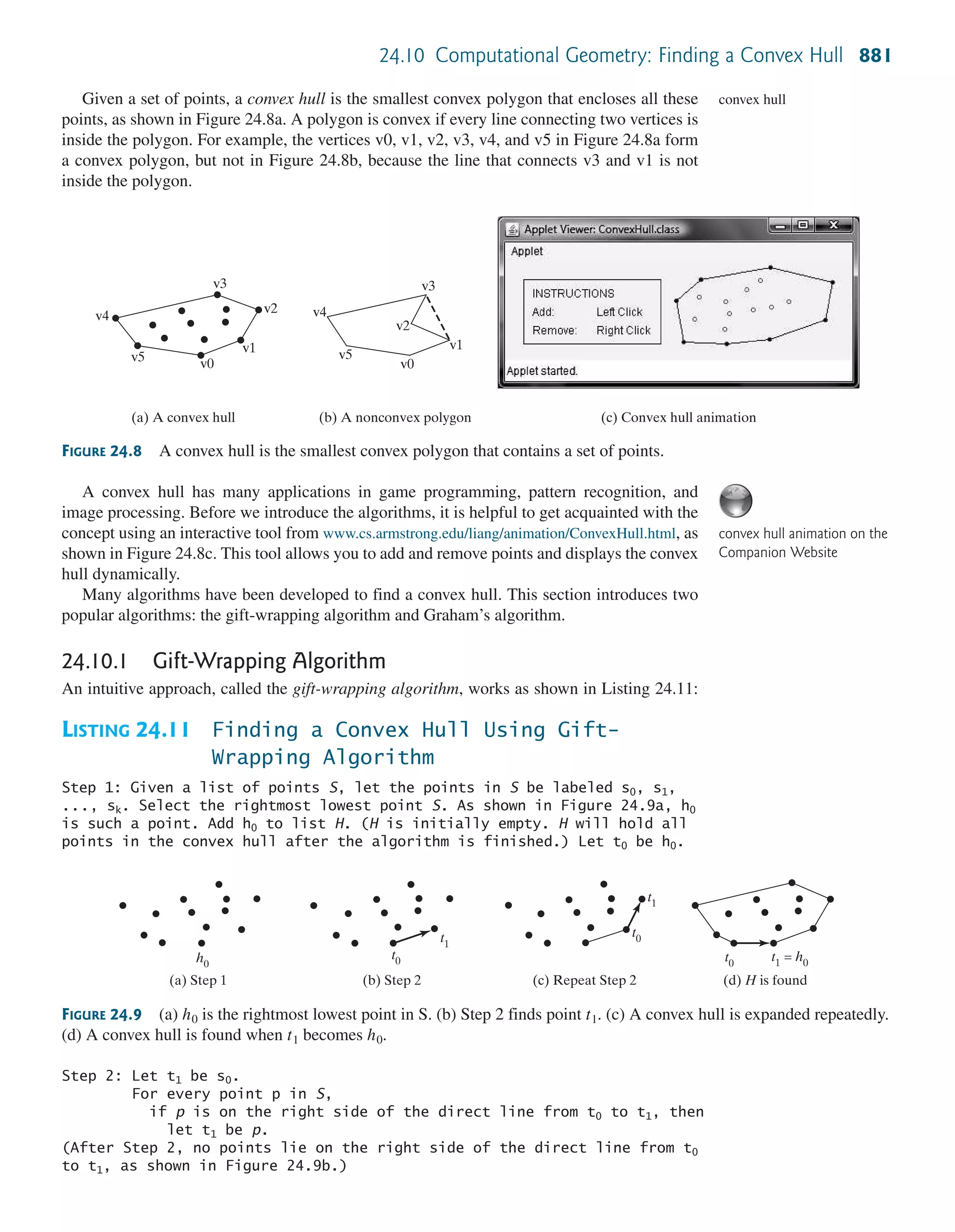

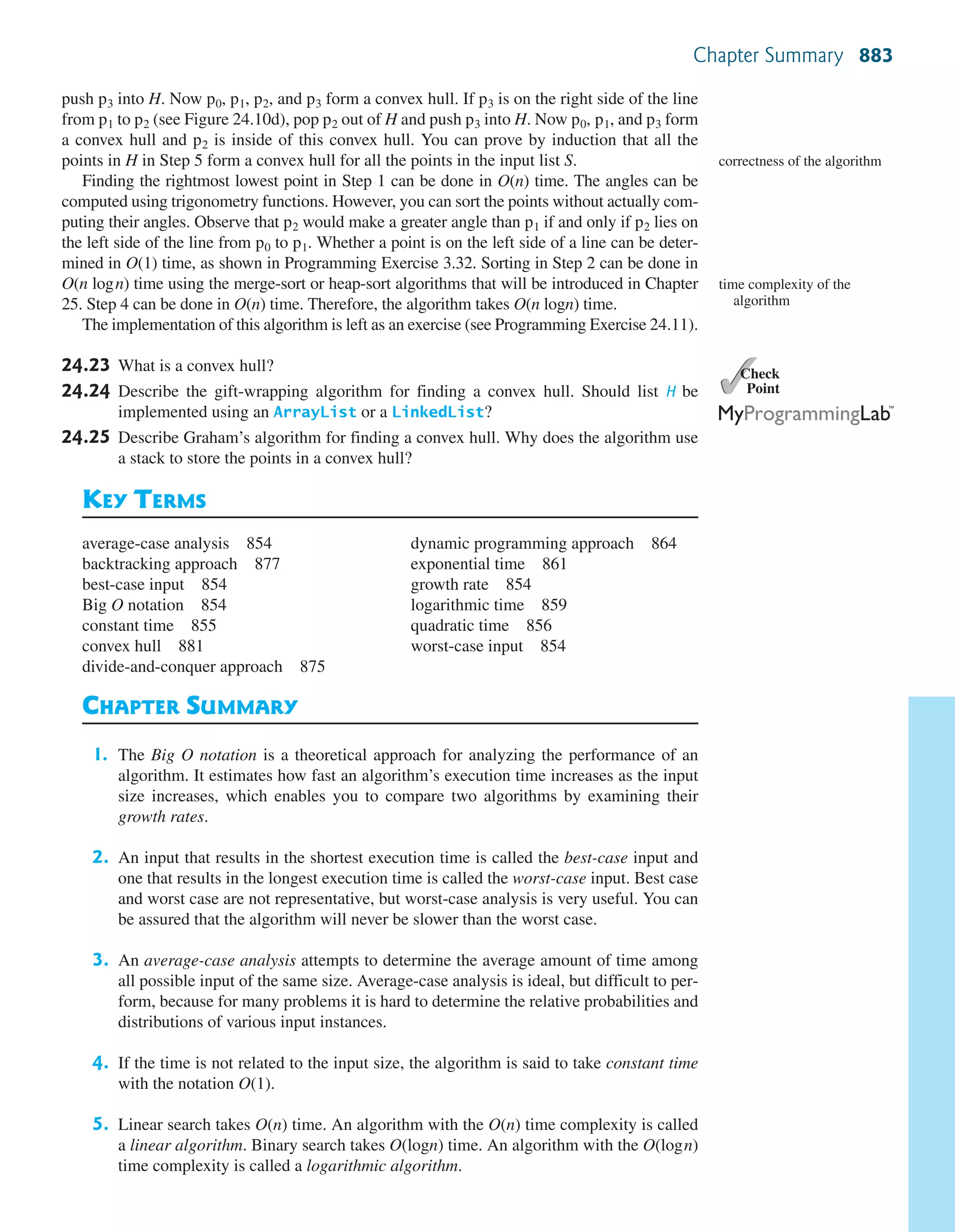
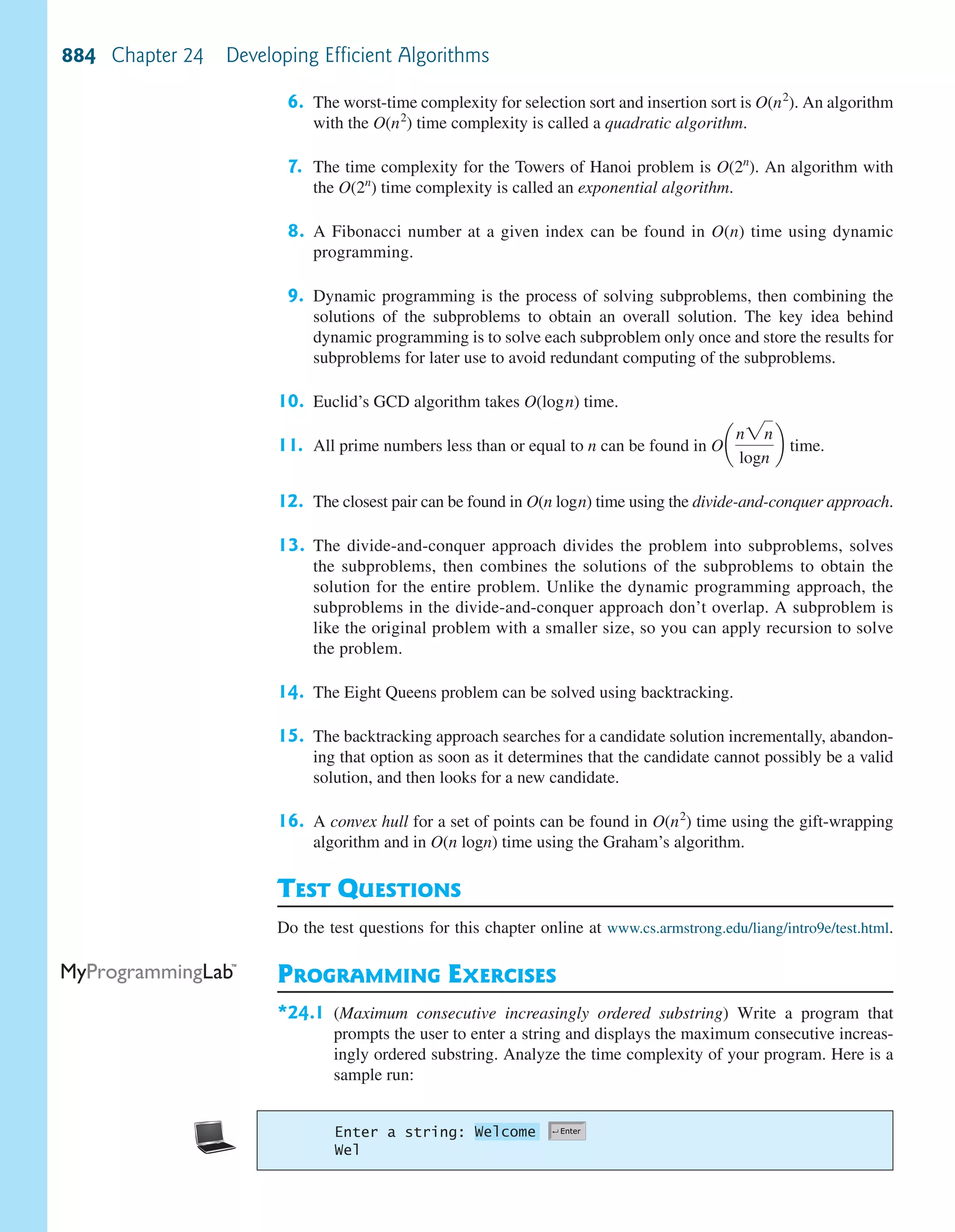
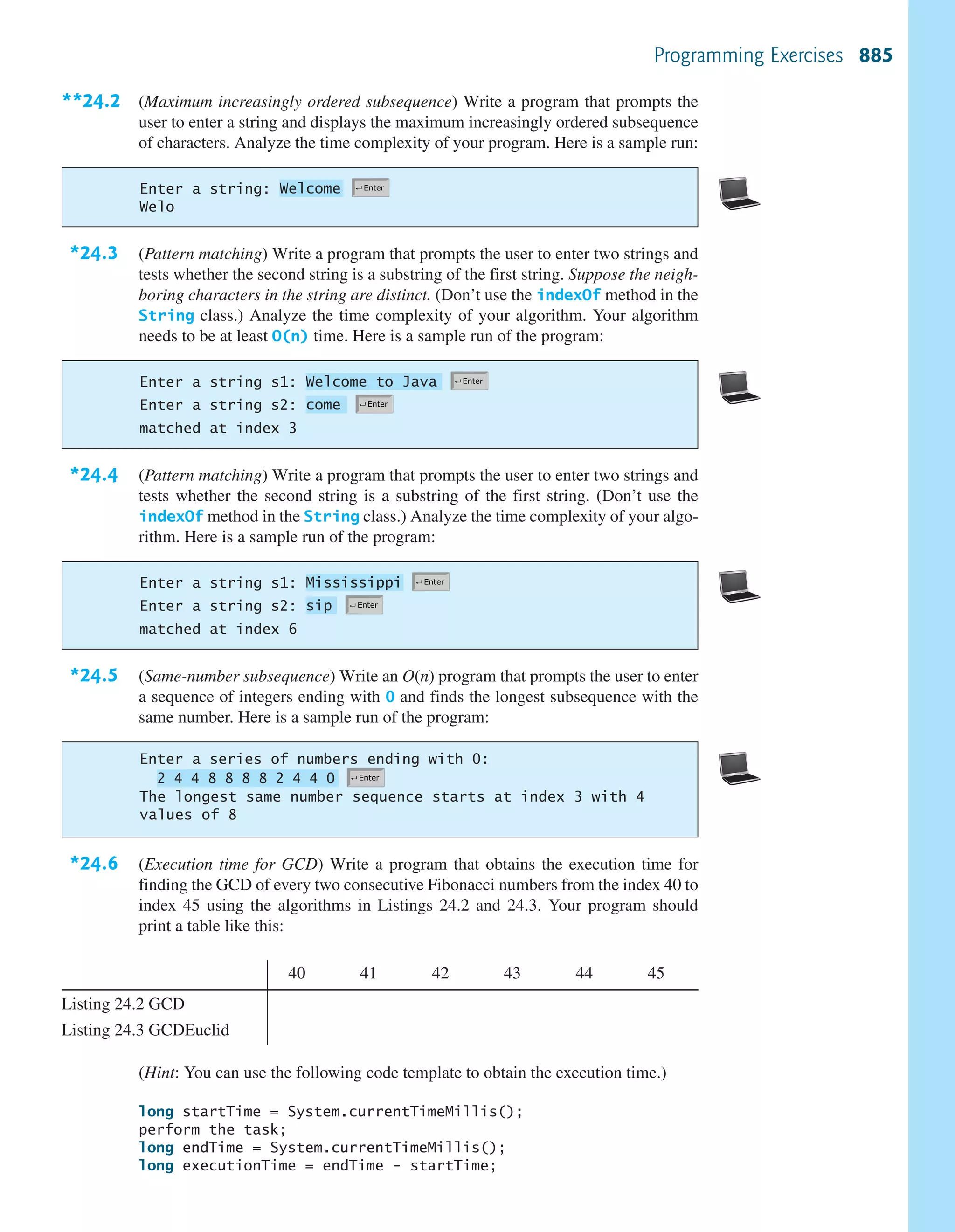
![886 Chapter 24 Developing Efficient Algorithms
**24.7 (Closest pair of points) Section 24.8 introduced an algorithm for finding the clos-
est pair of points using a divide-and-conquer approach. Implement the algorithm
to meet the following requirements:
■ Define the classes Point and CompareY in the same way as in Programming
Exercise 22.4.
■ Define a class named Pair with the data fields p1 and p2 to represent two
points, and a method named getDistance() that returns the distance between
the two points.
■ Implement the following methods:
/** Return the distance of the closest pair of points */
public static Pair getClosestPair(double[][] points)
/** Return the distance of the closest pair of points */
public static Pair getClosestPair(Point[] points)
/** Return the distance of the closest pair of points
* in pointsOrderedOnX[low..high]. This is a recursive
* method. pointsOrderedOnX and pointsOrderedOnY are
* not changed in the subsequent recursive calls.
*/
public static Pair distance(Point[] pointsOrderedOnX,
int low, int high, Point[] pointsOrderedOnY)
/** Compute the distance between two points p1 and p2 */
public static double distance(Point p1, Point p2)
/** Compute the distance between points (x1, y1) and (x2, y2) */
public static double distance(double x1, double y1,
double x2, double y2)
**24.8 (All prime numbers up to 10,000,000,000) Write a program that finds all prime
numbers up to 10,000,000,000. There are approximately 455,052,511 such
prime numbers. Your program should meet the following requirements:
■ Your program should store the prime numbers in a binary data file, named
PrimeNumbers.dat. When a new prime number is found, the number is
appended to the file.
■ To find whether a new number is prime, your program should load the prime
numbers from the file to an array of the long type of size 10000. If no number
in the array is a divisor for the new number, continue to read the next 10000
prime numbers from the data file, until a divisor is found or all numbers in the
file are read. If no divisor is found, the new number is prime.
■ Since this program takes a long time to finish, you should run it as a batch job
from a UNIX machine. If the machine is shut down and rebooted, your program
should resume by using the prime numbers stored in the binary data file rather
than start over from scratch.
**24.9 (Geometry: gift-wrapping algorithm for finding a convex hull) Section 24.10.1
introduced the gift-wrapping algorithm for finding a convex hull for a set of
points. Assume that the Java’s coordinate system is used for the points. Implement
the algorithm using the following method:
/** Return the points that form a convex hull */
public static ArrayList<MyPoint> getConvexHull(double[][] s)](https://image.slidesharecdn.com/ch24efficientalgorithms-140813175338-phpapp02/75/Ch24-efficient-algorithms-34-2048.jpg)
![MyPoint is a static inner class defined as follows:
static class MyPoint {
double x, y;
MyPoint(double x, double y) {
this.x = x; this.y = y;
}
}
Write a test program that prompts the user to enter the set size and the points and
displays the points that form a convex hull. Here is a sample run:
How many points are in the set?
Enter 6 points:
The convex hull is
(1.5, 34.5) (5.5, 9.0) (6.0, 2.4) (2.5, 2.0) (1.0, 2.4)
1 2.4 2.5 2 1.5 34.5 5.5 6 6 2.4 5.5 9
6
24.10 (Number of prime numbers) Exercise 24.8 stores the prime numbers in a file named
PrimeNumbers.dat. Write a program that finds the number of prime numbers that
are less than or equal to 10, 100, 1,000, 10,000, 100,000, 1,000,000,
10,000,000, 100,000,000, 1,000,000,000, and 10,000,000,000. Your
program should read the data from PrimeNumbers.dat. Note that the data file may
continue to grow as more prime numbers are stored in the file.
**24.11 (Geometry: Graham’s algorithm for finding a convex hull) Section 24.10.2 intro-
duced Graham’s algorithm for finding a convex hull for a set of points. Assume
that the Java’s coordinate system is used for the points. Implement the algorithm
using the following method:
Programming Exercises 887
/** Return the points that form a convex hull */
public static ArrayList<MyPoint> getConvexHull(double[][] s)
MyPoint is a static inner class defined as follows:
private static class MyPoint implements Comparable<MyPoint> {
double x, y;
MyPoint rightMostLowestPoint;
MyPoint(double x, double y) {
this.x = x; this.y = y;
}
public void setRightMostLowestPoint(MyPoint p) {
rightMostLowestPoint = p;
}
@Override
public int compareTo(MyPoint o) {
// Implement it to compare this point with point o
// angularly along the x-axis with rightMostLowestPoint
// as the center, as shown in Figure 24.10b. By implementing
// the Comparable interface, you can use the Array.sort
// method to sort the points to simplify coding.
}](https://image.slidesharecdn.com/ch24efficientalgorithms-140813175338-phpapp02/75/Ch24-efficient-algorithms-35-2048.jpg)
